VICTORIAN BAR ANNUAL REPORT 2020





WENDY HARRIS QC

The past twelve months have been some of the most difficult in living memory for the Bar and for its members.
When I was honoured to be elected President in November 2019, my expectations about the challenges that leading the Bar would bring were considerably different to the reality that unfolded. The profound disruption caused by the pandemic has affected every member of the Bar, their families, friends, instructing solicitors, clients and, of course, our VicBar staff. As I write this Report, Melbourne is in its 208th day of restrictions, it is 215 days since the courts advised that no new juries would be empanelled, 103 days since the first judge alone trial and 96 days since the Online Magistrates’ Court opened. Only those reading this 2020 Annual Report with the privilege of history will be able to assess the ultimate impact of the pandemic on those in the community and on the justice system, tell us how many of the measures the courts adopted during the pandemic have evolved into more permanent features, and how the pandemic changed the practice of being a barrister.
We knew that the legal market was changing well before the pandemic hit. That’s why one of the key objectives of the Bar’s strategic plan is to maintain and expand the Bar’s market share – taking measures to address market misperceptions of how we work, what we charge, and the value that briefing a barrister, and briefing early, can bring to the result that a client enjoys. We spent considerable energy through 2019 and into 2020 engaging with the client community and external stakeholders to explain what we do and the benefits we provide to clients, both in court, and as advisors out of court.
The pandemic has exacerbated and accelerated the need to deal with these competitive challenges, which is why it has been crucial for the Bar to continue to evolve and adapt – listening to our clients, the courts, the regulator and others across the legal profession about their expectations of the Bar and its members. The market has told us, resoundingly, that in order to maintain the trust and confidence of those on whom we rely for our survival, we need to meet the community’s expectations of how barristers behave towards their clients and their colleagues, be upfront and transparent in our ethical and professional conduct, and reflect the diversity of the community in which we work.
In order to preserve the reputation and the influence of the Bar externally, there are a number of critical measures that we also need to take internally – these are laid out in our 2020–2024 Strategic Plan. Katherine Lorenz outlines what we have done in furtherance of that strategy, internally and externally, in the CEO’s Report (page seven). There are three overarching themes that I would like to highlight here that are critical to the prosperity of the Victorian Bar.

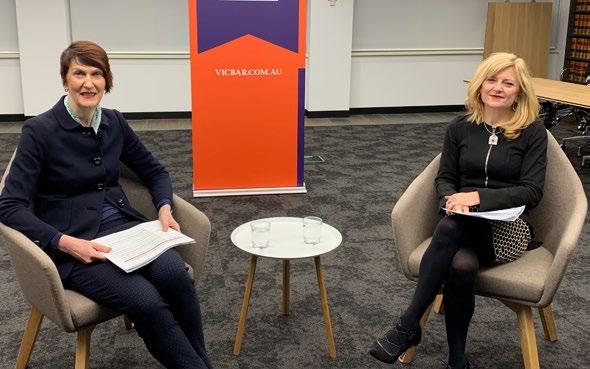
The first is to strengthen our college – while we may battle each other in court, we are members of a profession with a proud history of respect and collegiality within Chambers. The Bar is, of course, made up of people with diverse opinions, varied backgrounds and different experiences – and it is stronger for that. But we share universal professional standards and common values of decency and respect. That’s one of the reasons why I’m particularly supportive of our new Mentoring Pilot, which aims to bind the Bar closer together, including by strengthening the informal relationships and networks which have always existed alongside the traditional mentor/mentee relationship. That’s also why we are proactively addressing cultural issues at the Bar – those practices that undermine trust and respect between members, particularly where they turn a blind eye to sexual harassment, bullying and discrimination.
On our study delegation to the UK and Ireland earlier this year, we were introduced to the concept of the “Bar family” at the Northern Ireland Bar – with relationships built vertically, horizontally and diagonally through the membership. The result is that individual barristers have more connections to colleagues to call on for advice and support, and the college itself is strengthened because of the interchange of ideas and experience across generations, genders and cultures. The more that we can learn from each other and understand one another, the stronger our Bar will grow.
Having a more vibrant, interconnected college also makes the Bar an attractive proposition for newcomers. We know from the demographic surveys that members are joining us with considerably more legal experience in private practice, government or corporate legal teams than in the past. We’re privileged that 96 Readers chose to join the Bar last financial year – many have left roles with a steady income, collaborative environment and professional support infrastructure, for the life of an independent barrister, with all of the challenges and opportunities that provides. That’s why it’s important that the Bar develops as a modern membership organisation – with the social networks, educational offerings and rigorous policies that
will continue to make it a world-class, inclusive organisation attracting the best and brightest in Victoria’s legal community.
The Bar’s governance is key to this. The Victorian Bar is privileged to maintain effective self-regulation, under delegation from the Victorian Legal Services Board + Commissioner. We maintain this because of the trust that the regulator has in the governance framework that we have put in place, and strengthened since the revelations that led to the Royal Commission into the Management of Police Informants. We know that the actions of one member can cause a chink in the reputation of us all. It is a reminder that the reputation of the Bar is earned, not bestowed, and that we are judged individually and collectively for our excellence, professionalism and humility.
In my final words, I would like to acknowledge the work of the immediate past president, Dr Matthew Collins AM QC, for his stewardship of the Bar through the previous two years.
The Bar is considerably in his debt for his leadership during another challenging period. I would also like to recognise the enormous assistance that I have received this year from my fellow members of the Bar’s executive team, Simon Marks QC, Senior Vice-President, Sam Hay SC, Junior Vice-President, Stewart Maiden QC, Honorary Treasurer, and Katherine Lorenz, Chief Executive Officer. I would also like to thank my fellow Bar Councillors for their time and dedication over the past 12 months, all of the members who give their time voluntarily to contribute to our Committees, Associations, education programs and other Bar activities, and the members of the Victorian Bar staff for their professionalism and patience, without whom only a fraction of the goals we set ourselves could have been achieved.

Wendy Harris QC President
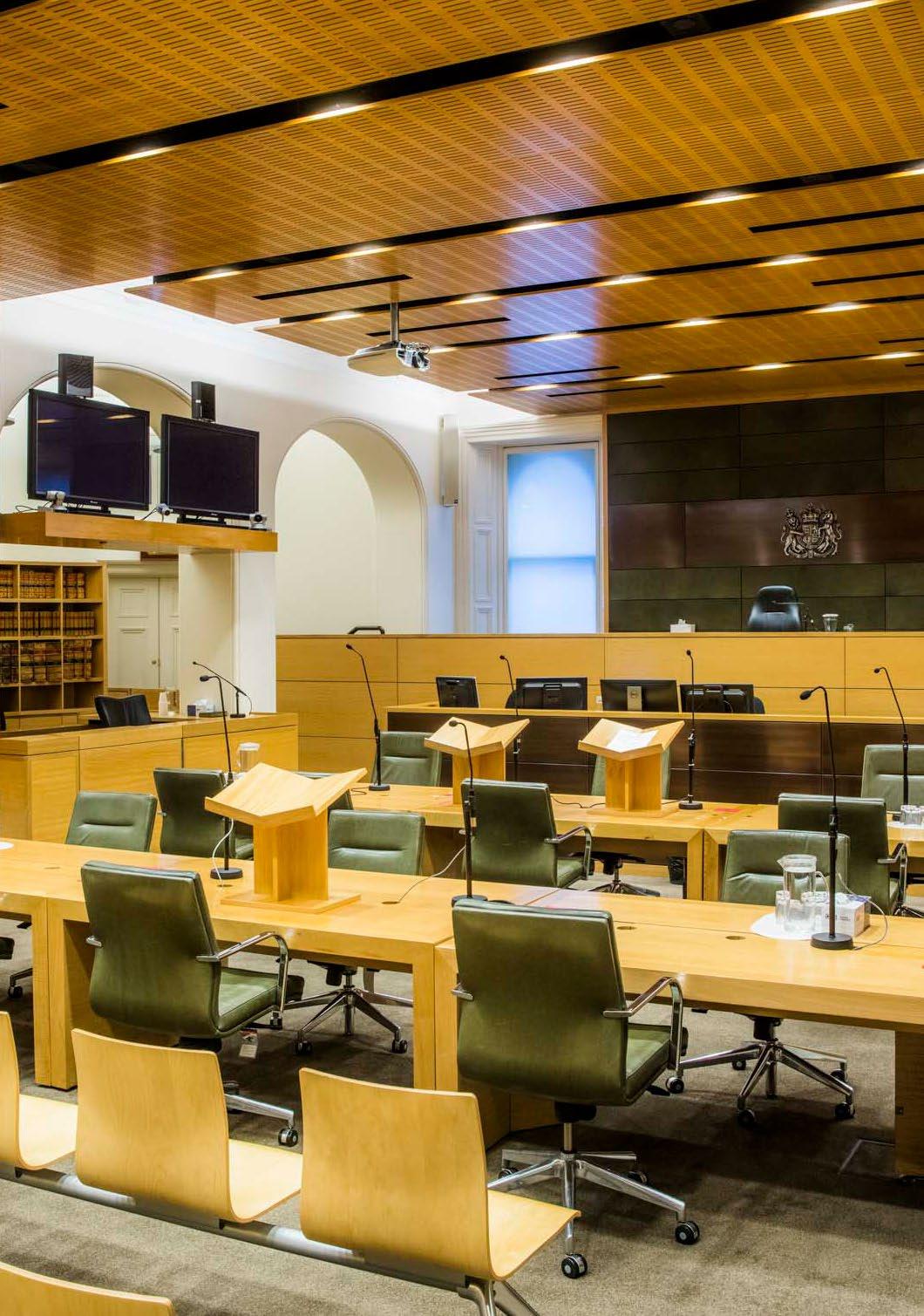

KATHERINE LORENZ
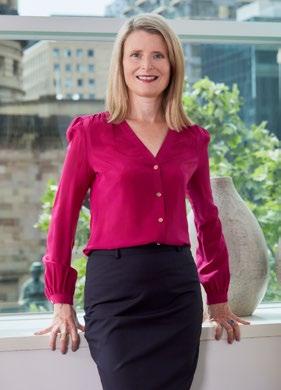
It’s impossible to read this Annual Report, written and collated in the homes of Victorian Bar members and staff during the COVID-19 lockdown, from outside the perspective of lockdown. But looking back, I now remember that three of the four quarters of the 2019–20 financial year were pre-COVID-19 in Victoria.
During the year, we made considerable inroads into implementing the Bar’s Strategic Plan, set by Bar Council in October 2019. The work continues under the four primary objectives of the strategy: to maintain and expand market share; to provide services to members to support and enhance their practices; to foster excellence and enhance the performance of Victorian barristers; and to provide leadership and a strong authoritative voice. In addition, we have been able to move forward on the seven priority projects that the Bar Council agreed in January would be of particular focus this calendar year.
When COVID-19 engulfed us in March, the VicBar team pivoted quickly and effectively to provide a fully functioning Bar office, replete with its educational, legal, finance, membership, marketing, communications and corporate services functions from their respective lounge and dining rooms, to support the rapid transition to virtual working. This included:
› transferring the Readers’ Course, which was in mid-delivery when restrictions were implemented, to an entirely online format without disruption, so that the 48 March Readers signed the Bar Roll on time and commenced their practices
› expanding our educational offerings to train members on how to operate in a virtual environment
› working with BCL to establish protocols to appropriately communicate with members in the event that COVID-19 was detected in Chambers
› providing financial support, including waived and reduced subscription rates, for members as the impact of COVID-19 took a toll on their fee receipts
› establishing new communications platforms to inform members about the rapidly changing court and government protocols
› liaising with government bodies, particularly as restrictions tightened, to advocate for those engaged in critical matters before the Courts to be able to access Chambers and child care, and
› supporting health and wellbeing initiatives across the Bar – from the COVID-Capsule mental health seminars to pilates, yoga and trivia – so that members remained connected through virtual networks.
COVID-19 forced our hands, and I’m proud that the Victorian Bar team adapted, and has been able to meet our financial-year targets and stay on track with delivering on our four key strategic objectives outlined below, while providing new services to members to help them to adapt to the extraordinary circumstances that unravelled in 2020.
To provide leadership and a strong, authoritative voice
Contributing to matters of public and legal importance is critical to maintaining the Bar as a respected organisation in the community. The Bar made 23 policy submissions during the last financial year, and positioned itself as the leading voice in the media on a number of issues affecting our community: human rights; ethical governance; sexual harassment; the bushfire response; and, then, on the impact of COVID-19 regulations.
The Bar, with the Pro Bono Committee, participated in Disaster Legal Help Victoria (DLHV) – a joint initiative of Victoria Legal Aid, the Federation of Community Legal Centres, the Law Institute of Victoria, the Victorian Bar and Justice Connect – as DLHV coordinated the pro bono legal response to assist those devastated by the Victorian bushfires.
Indeed, one of the most significant projects of 2019–20 was the launch of the Pro Bono Platform, by the Attorney-General and the Chief Justice of the Supreme Court, in November 2019. The platform enables courts to refer pro bono work to the Bar through a direct online portal, making the process more efficient and allowing more members of the Bar to be involved more easily in pro bono activities. Since the platform went live at the beginning of June, 22 cases were referred by the courts and 59% of jobs were accepted by a Bar member within 20 minutes.
As the pandemic hit, we published guides to the pandemic legislation, and to the operations of the courts, to help the Bar, legal profession and community navigate the rapidly changing environment. In April, we launched the “In Conversation” webinar series, in which heads of jurisdiction discussed the
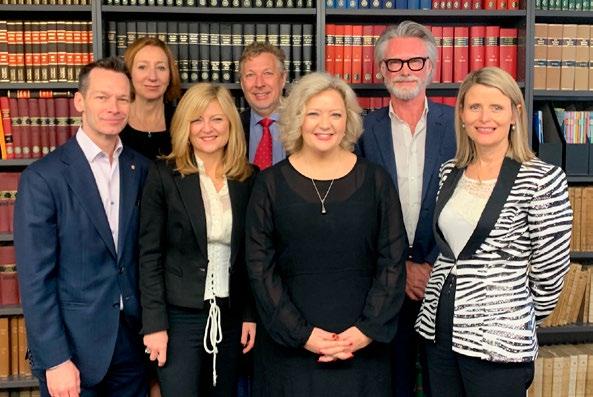
challenges COVID-19 wrought on the courts, a series quoted in the media and featured on ABC-TV News.
A strong and authoritative voice externally is dependent upon strong and effective governance internally. In 2019–20, the legal team developed a new Governance Framework for the Bar that details the fundamental structures, principles and mechanisms the Bar has in place to ensure effective governance, continual performance improvement, and to meet corporate obligations and legal requirements.
Demonstrating strong governance externally was evidenced as we responded to requests from the government, the regulator, the courts, and the Royal Commission into the Management of Police Informants. This was vital in retaining the confidence of the Victorian Legal Services Board + Commissioner (VLSB+C),
under whose delegated authority the Bar operates. The inhouse legal team provides strong support to the Bar Council and Counsel Committee with respect to the discharge of the Bar’s delegated functions.
To foster excellence and enhance the performance of Victorian barristers
The reputation of the Bar is predicated on the excellence and professionalism of our members. Critical to this is the education team’s role in coordinating the Readers’ Course and CPD program.
A rich CPD program was offered to members, with more than 90 seminar sessions held over the year covering members’ diverse areas of interest. This included webinars that ensured members remained engaged and could continue their professional development despite COVID-19. Bar Associations and Committees availed themselves of this capability and we arranged 22 webinars between April and June 2020, specifically to help members adapt to COVID-19.
We commissioned and completed 28 new case study problem scenarios, testing mock trials for each problem, for various education programs including the Readers’ Course, under the supervision of senior advocacy instructors. The new problems were introduced into education programs from February, providing contemporary learning tools for teaching programs and better learning outcomes for participants. I have written above about the extraordinary pivot of the March Readers’ Course as COVID-19 took hold – as the education team front-loaded the most critical in-person advocacy training, and then coordinated 15 new or heavily revised sessions for the delivery into the Course.
Several of the Bar Council’s priority projects in 2020 focused on fostering excellence and continual improvement at the Bar. One of these was the review of the Bar’s educational offering, aimed at ensuring the Bar continues to offer world-class, best practice professional education and training. The review involved extensive consultation with members and external stakeholders among the judiciary, law firms, clients, the regulator and other legal professionals. Aligned with the Education Review, the Indictable Crimes Certification Review has been undertaken and is, at time of writing, now concluding.
Another of the Bar Council’s priority projects for 2020 was the Mentoring Program Pilot, which the President has written about in her Report. The new mentoring scheme was informed, in part, by consultations and observations at Bars in Australia and the UK in the third quarter of the year, and the scheme, which was formally launched this September, has been oversubscribed by members.
Supporting the growth of members’ practices so that they can thrive now and into the future is the Victorian Bar’s purpose.
As the President has written in her message, the legal market continues to change, and it’s imperative that the Bar is not only able to adapt to the new environment, but is leading the way with innovative ideas that provide better solutions for clients and broader access to justice.
A critical element of this is the Bar Council’s priority project on fee recovery and workflows for criminal barristers. The project was scuppered by COVID-19, when the stakeholders at the courts, government agencies and clerks were focused on the pandemic response. Yet the pandemic, of course, also presented new challenges to workflows, with the catastrophic drop off in court work affecting Criminal, Family and Children’s Court practices.
The President and I, in collaboration with the Criminal Bar Association, have negotiated a fee payable for the case management hearing process introduced in the County Court,
605
and for fees to be paid in judge alone trial applications. One upside of the pandemic has been improved payment times from Victorian Legal Aid and the Office of Public Prosecutions.
COVID-19 has necessitated innovation, and we were delighted to support the ADR Committee with the June launch of the Expediated Mediation Scheme, which provides an avenue to fast-track court-ordered mediation, and assisted with the development of the new Victorian Commercial Arbitration Scheme, which was launched in October.
The Bar’s client community engagement strategy is another major part of retaining and expanding market share – executed through building a strong relationship with the Association of Corporate Counsel, involvement in conferences such as the General Counsel Summit, and developing stronger ties across the Bar with government legal teams, such as the Victorian Government Solicitor’s Office. Through this, we’ve built opportunities to speak directly to the market about the value of engaging counsel, not only to advocate in court, but as advisors in the governance and strategy of clients. Unfortunately, COVID-19 interrupted the start of a targeted law firm engagement project, which is kicking off in October 2020.
The Victorian Bar continues to hold a strong reputational position in the community. The VicBar reception receives on average 75 calls per week from members of the public seeking information about barristers’ services. There were more than 1.5 million website visits and, now with dedicated resourcing, our social media followers increased by 21% in the 12 months to June 2020 – with 202 posts publicising VicBar and Bar Associations’ CPDs and events, awards and recognition achieved by our members, welcoming new Readers to the Bar, and the activities from across the courts and wider legal profession.
Engaging with members, external stakeholders, aspiring students and the public through modern communications channels has opened new avenues to promote the Bar and the
critical work that members do in supporting access to, and the administration of, justice for all in our community. It has also supported the Bar’s message reaching new sections of the public, through events such as Law Week, conducted entirely virtually in May 2020, with four Bar events 'attended' by 380 members of the public. And it’s very pleasing that the Bar’s engagement strategy with new members led to the highest registration for the Bar Entrance Exam on record.
Of course, the work that the education, corporate services and marketing teams have done in facilitating the change to online events and CPDs has been critical to ensuring that we sustain and develop new practice and client opportunities in this new online world, without compromising the Bar’s reputation, excellence or professionalism.
To provide services to members to support and enhance their practices
The Victorian Bar retains regulation of its members under delegation from the VLSB+C. Maintaining and enhancing the Bar’s standards of professional conduct are critical to discharging that delegation, and the membership and legal teams play a central role in guiding members through the practising certificate renewal process, Professional Standards Scheme renewals, and assisting the VSLB+C with investigations of members.
Enabling the Bar to attract, retain and develop talent is a vital part of the Bar’s diversity and inclusiveness. In conjunction with the Supreme and Federal Courts, the Bar administers and funds the Indigenous Clerkship Program, which involves members hosting a clerk for a week during the program.
In June, the Bar joined Diversity Council Australia, an essential step to reinforce our commitment to equality and diversity externally and to provide members with access to information and training to support education on diversity and inclusion.
Members’ health and wellbeing is of critical importance for the Bar to meet its strategic purpose – to ensure that the Bar and its
members thrive now, and into the future. In November 2019, the Bar secured the services of a second counselling service, and supported and funded 320 counselling sessions in the financial year. We have also supported members on parental leave by subsidising Chambers rent and Bar subscription fees. The Bar also supported the return of 20 members to their practices at the Bar. The pandemic obviously raised the importance of addressing the mental health of our members, and providing supportive infrastructure for members during the lockdown. The “COVID Capsule” mental health seminars held in June provided members with an educational framework for understanding mental health issues, and we are developing a new health and wellbeing web portal, with VLSB+C funding, to deliver relevant information to address barristers’ needs. The corporate services team has arranged and supported health and wellbeing activities such as trivia, yoga, pilates and meditation workshops.
706 Member communications
2,124
Members guided through PC renewals
40
COVID-19 updates collated and distributed
45 Welcomes, farewells and obituaries
$37,300
Raised for the Victorian Bar Foundation
$65k
Rental subsidies for those on parental leave
1,265 Members guided through PSS renewals
20
Members supported in their return to practice
320+
Counselling services for members and their families funded
Timely and transparent communications are essential in any organisation, but never more so than in the extraordinary situation that the pandemic wrought. The communications team sent 40 COVID-19 updates from 6 March to 30 June, collating information from the government, the courts and the profession, as well as assisting BCL with their communications, to keep members informed about the rapidly changing operating environment. The VicBar team collated, wrote and/or distributed weekly 'In Brief' emails and other communications from the President, Bar Council and myself, as well as the President’s and others' speeches, welcomes, farewells and obituaries. The team also distributes communications for many of the Bar’s Associations and Committees.
Early in the pandemic, it became apparent that COVID-19 was going to have a significant financial impact on many of our members. As a result, the Bar approved discounts for member subscription fees for the 2020–21 financial year. Nil fee invoices were issued to 310 members by the membership team, discounts of between 25 and 50% were granted to a further 790 Victorian practising members and there was no increase to the remainder of members’ fees. In addition to these discounts, the Bar also assessed and granted hardship relief on a case-by-case basis at levels well in excess of previous years.
$76,970
Raised for the Peter O’Callaghan QC Gallery
110 Bar Roll division movements
$55,165
Raised for the Barristers’ Benevolent Association
Finally, Victorian Bar members themselves have been very generous in their donations to the Barristers’ Benevolent Association, the Victorian Bar Foundation, and the Peter O’Callaghan QC Gallery.
I’ve been incredibly proud to work with a great team of professionals at the VicBar, who work diligently under the best of times, but, when COVID-19 struck, have maintained businessas-usual activities as well as pivoting, under these extraordinary circumstances, to deliver on the Bar’s strategic objectives, and to assist the membership. When members write to the President, Bar Council or me about the role of the VicBar team – this is our role – to ensure, through our hard work and professionalism, that the Bar and its members thrive now and into the future.

Katherine Lorenz CEO






















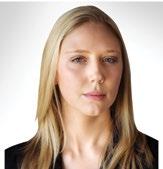


Six meetings of the Victorian Bar Council were held between 1/7/19 and 14/11/19 (being the date of the final meeting of the 2018-2019 Bar Council), including one Special Purpose Bar Council meeting. Twelve meetings were held between 14/11/19 (being the date of the first meeting of the 2019-2020 Bar Council) and 30/6/2020 including three Special Purpose Bar Council meetings.





















Committee as at 30 June 2020: Melissa Stead (President) (now Magistrate), Samantha Renwick (Honorary Treasurer), Teresa Porritt (Honorary Secretary), Christine Pollard, Judy Benson, Arna Delle-Vergini, Vicki Marty.
The Children’s Court Bar Association is comprised of dedicated counsel who work in a unique area of law that is dynamic, challenging and rewarding.
This year has been difficult for everyone, and this has especially been highlighted by the challenges posed by COVID-19 in being able to continue to properly represent those who come before the Children’s Court. In order to meet these challenges, the Children’s Court has implemented a number of different processes and procedures. All court proceedings are now able to occur via remote hearing. This includes contested hearings, conciliation conferences, emergency care matters and the newly introduced readiness hearings.
In order to support our members to pivot to this mode of appearance, there have been a number of CPD sessions hosted by the Children’s Court CPD Committee, of which our President, Melissa Stead (now Magistrate) is a committee member. These have included preparing for and presenting via Webex; submissions contests when briefed by the Department of Health and Human Services; and Webex readiness hearings. Melissa has also been involved in webinars that discuss the Court’s COVID-19-related Practice Directions. Most recently, Melissa has been involved in a webinar with President of the Children’s Court, Judge Chambers, to discuss the changes implemented by the Court in response to COVID-19.
The Association also remains committed to advocating for fairer briefing fees by Victoria Legal Aid and the Department of Health and Human Services.
The Victorian Bar congratulates Melissa Stead on her appointment as a Magistrate on 22 September 2020.
Committee as at 30 June 2020: Claire Harris QC (President), Paul Hayes QC (Senior Vice-President), Stewart Maiden QC (Junior Vice President/Convenor), Sam Rosewarne (Treasurer), Emma Murphy (Honorary Secretary), Veronica Holt (Assistant Honorary Secretary), Dr Oren Bigos SC, Hamish Redd, Kieran Hickie, Jesse Rudd, Georgia Berlic, Raini Zambelli.
Nicholas (Nick) Hopkins QC retired as the President of CommBar at the November 2019 AGM. CommBar acknowledges and thanks Nick for his substantial contribution to the Association.
Upon Nick retiring, Claire Harris QC was appointed President, Paul Hayes QC was appointed as Senior Vice President and Stewart Maiden QC was appointed as Junior Vice President.

Despite its challenges with the impact of COVID-19 on the practice of law, the 2019/2020 financial year has been busy and rewarding for CommBar.
The year started on a high with the annual CommBar function held at the Federal Court of Australia on 19 February 2020. The event, co-hosted at the Federal Court by Chief Justice Allsop and Chief Justice Ferguson, was well attended by external solicitors (including in-house counsel), and members of the judiciary and the Bar. The Executive has had positive feedback, including as to the timing of the event which coincided with the commencement of the legal year rather than in the busy end-of-year season.
Not long after the function, the Executive, noting the early stages of the COVID-19 pandemic, determined to cancel the biannual CommBar conference to be held in Penang, Malaysia, in September 2020. While the Executive was disappointed to do so, it remains committed to a replacement event in the near future (subject to COVID-19 limitations), possibly in regional Victoria given the devastating impacts of the 2019/2020 bushfire season.
CommBar was pleased to again be central in awarding the CommBar Alan Goldberg Readers’ Bursary (in March 2020). The bursary was established in 2018/2019 and aims to support young commercial practitioners intending to practise commercial law at the Victorian Bar. To date, CommBar has proudly paid the bursary to three readers. The bursary covers the fees for the readers’ course and entry exam. It was heartening to see another strong, diverse and worthy pool of applicants for the March 2020 bursary. CommBar hopes to continue to support this cause in the future.
Other work that the Executive has continued to progress on behalf of CommBar members includes:
› Supporting members through the COVID-19 pandemic. Work has included consultation with the Victorian courts about practice changes arising from the pandemic, establishing a dedicated website hosting relevant practice material, actively considering how best to support members’ practices such as by promoting the return to oral (in-person) advocacy as soon as is prudent and working with members about the potential for arbitration to assist with any backlog in the determination of cases pending in courts and/or tribunals.
› Hosting a range of CPDs both through its sections, and centrally through CommBar, and actively involving the judiciary in relevant CPDs wherever possible, as well as collaborating with Melbourne and Monash Universities on CPD offerings.
› Establishing an alliance with the Association of Corporate Counsel, which will involve a number of shared CPD and networking events in the coming year.
› Considering and facilitating submissions on the Justice Legislation Miscellaneous Amendments Bill 2019, Contingency Fees in Class Actions.
› Redefining the role and function of Sections, and work on reinvigorating the Sections with steps to more formal facilitation of Section membership.
› Consulting with Sections regarding potential areas of law reform in Victoria.
› Reviewing and renewing sponsorships directed towards providing speaking and general networking opportunities for members.
› Reviewing website hosting options.
› Contributing through Sections and members to the CommBar Matters blog, which is available through the Bar website but also promoted internationally through Lexology.
› Negotiating the continued subscription to Lexology for the benefit of members.
CommBar looks forward to progressing the organisation’s objectives into the 2020/2021 financial year.
Committee as at 30 June 2020: Ross Gillies QC (Chairman), Mary Anne Hartley QC (Treasurer), David Martin (Secretary), Tim Tobin SC, James Mighell QC, Andrew Clements QC, Róisín Annesley QC, Áine Magee QC, Michelle Britbart QC, Fiona Ellis, Patrick Over, Gavin Coldwell, Stephen Jurica, Michael Clarke, Stella Gold, Julia Frederico, Gemma-Jane Cooper, Raph Ajzensztat, Scott Davison, Tristan Nathanielsz, Peter Haddad.
During the year, the Common Law Bar Association has been involved in a number of activities including:
› Continued liaison with judges of the Supreme Court, in particular Justice J Dixon, Justice Keogh and Justice Incerti, and Associate Justice Clayton regarding the conduct of common law trials in the Supreme Court.
› Meetings with judges of the County Court, in particular Judge O’Neill, Judge Misso and Judge Tsalamandris.
› Representation on the various User Groups including the Personal Injuries List, the Medical List and the Dust and Diseases List and “Key Points Bulletins” emanating from the Court following meetings of the various User Groups have been circulated to members.
› The Association has been assisted by submissions drawn by members of the CLBA both to Government and to VicBar.
› The Association jointly sponsored the AILA Conference and Dinner in 2019. That sponsorship is to continue in 2020.
› There has been a modest increase in the number of common law CPDs. A sub-committee was formed to organise CPDs during 2020. The sub-Committee consists of Áine Magee QC, Gemma-Jane Cooper, Raph Ajzensztat, Peter Hamilton and Patrick Over.
› A County Court Users Group from the Association has been appointed at the request of Judge Misso. The subcommittee consists of James Mighell QC, Michelle Britbart QC and Michael Clarke.
› Providing case summaries of recent court decisions to its members.
› Continued discussion with the Transport Accident Commission and the Victorian WorkCover Authority concerning a variety of matters pertaining to the conduct and hearing of common law matters arising as a result of transport accidents and industrial accidents.
› The COVID-19 pandemic has provided many challenges for the conduct of litigation. The Association has met via Zoom on a number of occasions with Judge Tsalamandris and other stakeholders to discuss and ultimately implement various strategies which have enabled common law trials and serious injury applications to be heard remotely. The discussions and consultations are ongoing.
› Hosting a very successful dinner following the Annual Meeting on 21 November 2019.
Membership of the Common Law Bar Association continues to increase. Currently, 344 members of the Victorian Bar are members of the Common Law Bar Association.
Former committee member Judge David Purcell was appointed to the County Court and Fiona McLeod AO SC did not seek re-election to the committee at its annual meeting on 21 November 2019.
The Association would like to record, acknowledge and thank both of them for the outstanding contribution which each of them has made to the Common Law Bar Association over many years.
Committee as at 30 June 2020: Ian McDonald SC (Chairman), Megan Cameron (Secretary), Ray Ternes (Treasurer), Bruce McKenzie, Nicholas (Nick) Horner, Maria Tsikaris, Sascha Dawson, Kim Bradey, Robert Paoletti, Peter Haddad, Kathy Karadimas.
The past year has been one of transition for the CLBA, with an appointment from its ranks, and considerable changeover of personnel.
The CLBA congratulates Michael Richards on his appointment as Magistrate and wishes him a long and productive career on the Bench. The CLBA also thanks Mr Richards for his long years of service to the Association as a representative on the WorkCover Users’ Group, and membership of the committee generally.
For more than a decade, Bruce McKenzie has contemporaneously distributed judicial decisions relevant to the CLBA. This has been of enormous assistance to those practising in the jurisdiction. Bruce has decided to ‘pass the baton’ after many years of service, and the CLBA offers its profound thanks to him. We are also grateful to Maria Tsikaris volunteering to take on this important role.
In a similar display of commitment, Anthea MacTiernan was, for many years, Secretary of the CLBA. We are indebted to her for her tireless organisation and record-keeping for the association. We also thank Megan Cameron for assuming this position.
Nick Horner has served, along with Mr Richards (now Magistrate), as the CLBA’s representative on the WorkCover Users’ Group, and we thank him for his service. The new CLBA representatives liaising between the Court and the association are Kim Bradey and Megan Cameron. We thank Kim and Megan for taking on these roles.
The association also congratulates its Chairman, Ian McDonald SC, on his appointment as Senior Counsel in December 2019.
The CLBA continues as an active and vibrant association representing barristers specialising in statutory benefits at the Victorian Bar. Its current membership is approximately 134, including a significant number of senior counsel.
Earlier this year, the CLBA made a submission on behalf of its members to the Magistrates’ Court, to the effect that the archaic brief fee/refresher system was no longer suited to modern practice in the WorkCover list. The CLBA advocated for the system of daily fees, which has now long been in place in the County and Supreme Courts. The Court has received and is in the process of considering that submission.
The CLBA has hosted a number of CPDs during the course of the year, and the association is grateful to its members and others for their time in preparing and running these seminars. We particularly express our thanks to Magistrate Brian Wright for the excellent seminar on 20 February 2020 concerning VOCAT, as well as his ongoing support of the association more broadly.
Before COVID-19 changed Melbourne, drinks were a regular feature both after CPDs, and to mark occasions such as appointments. It is hoped that these useful social and networking events can resume again in the foreseeable future. These functions are free to all financial members of the association.
Committee as at 30 June 2020: Daniel Gurvich QC (Chair), Sally Flynn QC (Vice Chair), Anthony Lewis (Treasurer), Simon Moglia (Secretary), Jim Shaw, Jason Gullaci, Cecily Hollingworth, Megan Casey, Pardeep Tiwana, Paul Smallwood, Ffyona Livingstone Clark, Non-voting members since Covid 19: David Hallowes SC, Colin Mandy SC, Sharon Lacy, Rosalind Avis.
The suspension of jury trials and other criminal cases in March 2020 deeply impacted the lives of criminal barristers and the administration of criminal justice. The Criminal Bar Association (CBA) has been working with the courts and others to progress criminal cases in new and innovative ways.
The CBA has continued to engage with law reform bodies, the courts and chief briefing agencies. Key issues for the year included:
› Advocating for the retention of committal proceedings.
› Introduction of judge-alone trials.
› Cases conducted by remote facilities.
› The CBA provided many CPD sessions to promote the ongoing excellence of our membership.
Long-serving secretary and vice-chair, Megan Tittensor (now SC), resigned from the committee in March 2020, having been appointed a life member.
Additional members joined the committee when the pandemic struck. We thank David Hallowes SC, Colin Mandy SC, Sharon Lacy and Rosalind Avis.
We have congratulated Judges Anne Hassan, Kevin Doyle, Fran Dalziel, Sarah Leighfield and Fiona Todd, and Magistrates Hayley Bate, Andrew Halse, Helen Murphy and Victoria Campbell who have taken judicial appointments in the past year. We thank the Victorian Bar and the staff of the Bar office for their support of the CBA.
Committee as at 30 June 2020: Geoffrey Dickson QC (Chair), Caroline Paterson (Treasurer), Dr Robin Smith (Policy Officer), Jennifer Howe (Secretary), Alison Burt (CPD Coordinator), Gerard Holmes, Hilary Bonney, Andrew Barbayannis, Sarah Hession, Jeanette Swann.
The promotion of harmonious and collegiate relationships has never been more important to our profession than at the current time.
It has always been a key focus of the Family Law Bar Association to engage in functions and events that bought the profession together. This enables relationships outside of the workplace to form, which in turn enhances our relationships whilst at work. With the current expectations of the court to have conducted discussions and negotiations prior to any court appearance, those relationships are so important to the successful transition of the courts to the virtual world.

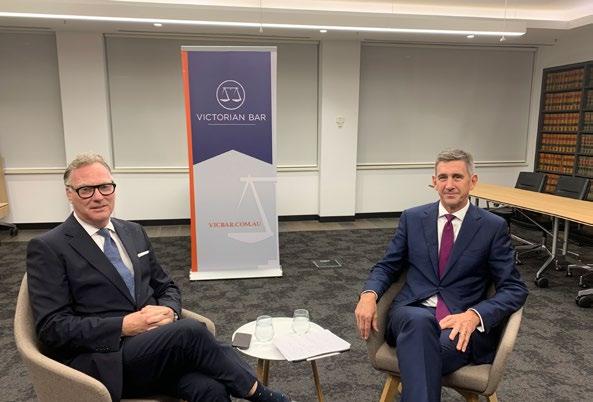
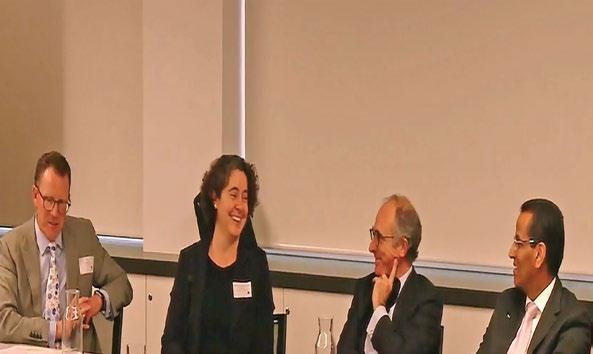
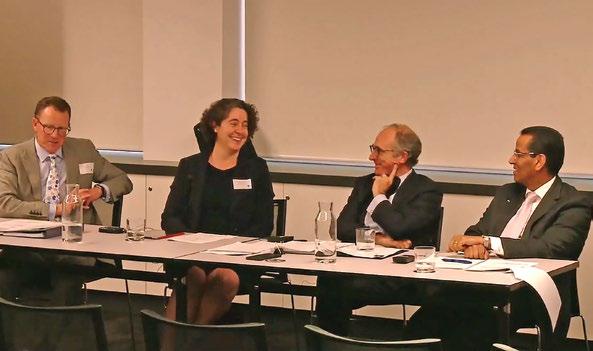
hopes to collaborate again with the Federal Court with a return (in December) of the popular Federal Court ‘conversation on current issues in the practice of employment and industrial law’.
On 21 November 2019, the IBA hosted its Annual IBA Dinner. In a break from tradition, a crowd of more than 50 gathered at MoVida Aqui to enjoy fine Spanish food, wine and a convivial atmosphere. The IBA paid tribute to recently retired barrister, Gerard McKeown, who was instrumental in the founding of the IBA and a long-standing member of, and contributor to, the IBA committee.
The IBA has continued to engage with the courts and the FWC through user groups and other forums, including in relation to the response to COVID -19. We are reminded of the importance of these relationships in these times.
The financial year commenced with much positivity within the Family Law Bar Association. We welcomed four new members and retained all of our previous members following a general election. Rory McIvor did not seek re-election for the committee. His contribution is appreciated, and we thank Rory for his time and input. New committee members provided a fertile ground for new initiatives and more hands to support the work already undertaken by members.
The end of year dinner at Caterina’s was once again a sell-out affair and a fabulous event. We always welcome and enjoy the attendance of judges from the Federal Circuit Court and Family Court. Building connections between the Bench and Bar, or just catching up with colleagues makes this event so popular.
We once again hosted the Bench, Bar and Solicitors Barefoot bowls night at the Flagstaff Bowls club. This year we hosted almost double the numbers from last year. This is an incredibly well-received event from all attendees.
The FLBA in conjunction with the Chief Justice of the Family Court were in the last stages of organising a gala ball event ‘A Night for the Profession’, an event to further solidify relationships within the profession. Unfortunately, as a result of the current restrictions in force that prohibit large gatherings, this event has been cancelled with the hope that it can be rescheduled for a date in 2021.
Everyone within the profession (including the courts) has had to adapt and learn new technology. It is with sincere thanks and gratitude to Alison Burt (CPD co-ordinator), Belle Lane and Martin Bartfeld AM QC for their teaching videos on the workings of Microsoft Teams and Zoom platforms for both online mediations and court appearances. These online CPD sessions were invaluable to all members.
The good news as we entered the second isolation period, was the appointment of Rohan Hoult as the Senior Registrar of the Family Court. Rohan has been a barrister for over 30 years and
a member of the FLBA for much of that time. He has been the deputy chair of the FLBA for over 10 years. His contributions to the FLBA, particularly his willingness to host so many of our functions, cannot be matched. The meetings of the FLBA will not be the same or with as many laughs, without him.
The FLBA will continue to liaise with the courts and key stakeholders to ensure that the profession is available and prepared to assist with the continuing access for our clients to the courts in whatever form that may take.
Here’s hoping for a less virtual next financial year.
Committee as at 30 June 2020: Catherine Symons (President), Malcolm Harding SC (Senior Vice President), Paul O’Grady QC (Vice President), Yasser Bakri (Treasurer), Kate Burke (Secretary), Craig Dowling SC, Richard Dalton QC, Rohan Millar, Andrew Bell, Nico Burmeister, Andrew Denton, Rebecca Preston.
The Industrial Bar Association (IBA) attracts counsel who undertake or have an interest in work in industrial and employment law. Its members (whose numbers are now approaching 210) typically practise in state and commonwealth courts and tribunals and represent the interests of employers, employees, representative bodies and regulators.
The 2019-2020 financial year has been a year like no other and created challenges for the IBA and its members. Despite this, the IBA largely managed to deliver its full complement of programs and initiatives, including convening as a committee in ‘cyberspace’, rather than in chambers.
In particular, the IBA coordinated and delivered a high-quality continuing profession development program (CPD) on topics of significance to its members and to the broader legal community. In this regard, the IBA continued to foster the
strong relationships between its members and solicitors who practise in the industrial and employment field and who were regular guests at CPD functions.
The events organised by the IBA during the 2019-2020 financial year included:
› On 25 July 2019, a CPD on Enterprise Agreements and judicial review of Fair Work Commission (FWC) decisions. The event was hosted by Rebecca Preston and Deputy President Gostencnik of the FWC, Richard Dalton QC and Malcolm Harding SC delivered papers;
› On 19 August 2019, a seminar titled A symposium on discrimination law: insights and recent developments, which featured presentations from Justice Bromberg, Kristen Hilton, Victorian Equal Opportunity and Human Rights Commissioner, Peter Hanks QC, Dr Laura Hilly, and Jenny Firkin QC (as Chair);
› On 10 October 2019, a series of presentations (hosted by Justice Bromberg and held in the Federal Court in Melbourne, with live streams to interstate Federal Court registries) featuring presentations from Kate Burke of the IBA (on the topic of class actions in the employment and industrial jurisdiction) and presentations from a range of counsel and solicitors representing Victoria, South Australia and Queensland; and
› On 31 October 2019, a CPD titled Keep an eye on the trial –practical measures to ensure your case runs smoothly, which involved a collaboration between the Bar (Paul O’Grady QC), the Federal Court (Justice O’Callaghan), the Supreme Court (Justice Richards) and the Federal Circuit Court (Judge Blake).
The IBA anticipates that whilst its CPD program for the second half of 2020 will look different to past offerings (being provided through an online platform), it will nonetheless deliver high-quality and relevant content on subject matter that includes: ‘enforcement of minimum entitlements – existing powers and proposed wage theft laws’ (a collaboration between the IBA and the Fair Work Ombudsman), a session on industrial law and a third session with a focus on employment law. The IBA also
The IBA is equally fortunate to have so many members contributing as committee members and as contributors to the CPD program. The IBA thanks Jenny Firkin QC, Marc Felman and Robert O’Neill for their valuable contributions to the work of the IBA committee over past years and welcomes new committee member Nico Burmeister.
The IBA also recognises the appointment of Malcolm Harding SC (current Senior Vice President) to the ranks of senior counsel in 2019 and the conferral of Queen’s Birthday Honours on the Honourable Shane Marshall AM for ‘significant service to the law, and to the judiciary, to industrial relations, and to mental health’.
Committee as at 30 June 2020: Guy Gilbert SC (President), Angel Aleksov (Vice-President), Krystyna Grinberg (Treasurer), Catherine Symons (Secretary), Georgina Costello SC, Christopher Tran.
The year was a busy one for the association.
A number of CPD events took place during the year. Solicitors from private practice, Victoria Legal Aid, Asylum Seekers Resources Centre, Refugee Legal, and firms representing the Minister, also attended.
As an example, two members of the association conducted a CPD seminar at the request of the Perth Bar, with Justice McKerracher moderating. It was held by video, between the Melbourne and Perth Federal Courts. Another was held at the Bar, the topic being an introduction to judicial review. It was designed to introduce new or younger practitioners to the area, chaired by a solicitor who was an accredited migration specialist, with speakers from the association, and the Australian Government Solicitor’s office.
There was liaison from time to time with the Migration Committee of the Federal Litigation Section of the Law Council, on matters of mutual interest. In March 2020 members of the
association were well represented at the Law Council’s annual Migration Law Conference, which took place in Melbourne. A number presented papers on complex aspects of migration and refugee law.
From time to time during the year, members of the association were sent a group email, to alert them to an important case that had been handed down, or a change in legislation. Informally also, members exchanged queries between themselves, or sought guidance as to a particular issue that was arising in a case. Again, a very useful network for members.
The demand for pro bono assistance continued during the year. The Federal Circuit Court and Federal Court Registrars regularly asked members to advise an unrepresented litigant and appear if there was sufficient merit. Justice Connect, ASRC and Refugee Legal made similar requests.
The Federal Court Pro Bono Working Group continued its work. The working group comprises Simon Haag, the Migration Registrar in the Melbourne Registry, with attendees from the association, the Bar’s Pro Bono Committee, and Justice Connect. This is an important point of contact between the Bar and the Federal Court.
During COVID, the association liaised with the Bar on matters concerning members, and with the Federal Circuit Court and Federal Court, to facilitate the listing of cases, particularly for those in detention.
Committee as at 30 June 2020: The Honourable Chief Justice William Alstergren (Chief Patron), Paul Panayi (President), Scott Davison (Vice President), Dan Coombes (Treasurer), Dr Robin Smith (Secretary), John (Jack) Rush RFD QC (Navy Patron), Vale - the Honourable Justice Richard Tracey AM RFD QC (Army Patron) , Andrew Kirkham AM RFD QC (Air Force Patron).
During the year, the Military Bar Association has been liaising with government, departmental and other stakeholders to provide advice and input into policy and legislative changes affecting military law in domestic and overseas operations, military discipline law and administrative law spheres.
Our members have been involved in a diverse range of activities, including: deploying to overseas operations; defending in courts martial trials; and advising government and military leaders.
While 2020 will be reminiscent of ‘a bloody war and a sickly season’, our members will continue to serve here in Australia contributing to COVID-19 response groups, as well as overseas in a variety of deployed roles.
The example set by our members during recent months has been in the finest traditions of the Service, and we thank them for their hard work and sacrifice.
It is with deep sadness that we acknowledge the passing of the Honourable Justice Richard Tracey AM RFD QC, whose profound contributions to military law in Australia will live on as a legacy and testament to his brilliant career.
Committee as at 30 June 2020: Terry Murphy QC (President), Daniel McInerney (now SC) (Vice-President), Eugene Wheelahan QC (Treasurer), Daniel Diaz (Secretary), Andrew Broadfoot QC, Dr Steven Stern, Ria Sotiropoulos, Angela Lee, Claire Nicholson, Hadi Mazloum, Anna Wilson, Fiona Cameron, Mia Clarebrough, Gareth Redenbach, Matthew Meng.
Membership: The association has a total of 147 members.
Continuing Professional Development: For the period 1 July 2019 to 30 June 2020, the Tax Bar Association presented eight continuing professional development seminars on behalf of the Victorian Bar as follows:
› 12 August 2019 – R&D Tax Incentives: The Full Court’s decision in Moreton Resources Ltd v Innovation and Science Australia [2019] FCAFC 120.
› 9 September 2019 – Glencore International AG v Commissioner of Taxation [2019] HCA 26. So where are we now with privilege?.
› 10 October 2019 – Transfer pricing recalibrated: Glencore Investment Pty Ltd v Commissioner of Taxation [2019] FCA 1432.
› 21 October 2019 – When is a taxpayer subject to ‘double taxation’?: The Full Court’s decision in Burton v Commissioner of Taxation [2019] FCAFC 141.
› 30 October 2019 – Commissioner of Taxation v Sharpcan Pty Ltd
– Reflections on the High Court decision.
› 14 November 2019 – Tax Issues in Family Law Proceedings–you can run but you can’t hide.
› 5 May 2020 – Make no mistake? The Michael Hayes Case.
› 19 May 2020 – BHP Billiton Limited v Commissioner of Taxation –“Sufficient Influence in Commercial Dealings” – the High Court rules on the associate definition in s 318 ITAA 1936.
In addition to the above, the Tax Bar Association’s members have delivered continuing professional development seminars to practitioners in other settings including:
› the provision of seminars to the Australian Taxation Office, the Tax Practitioners Board and Australasian Tax Teachers Association Conference; and
› delivering seminars to industry bodies such as the Tax Institute of Australia and Law Institute of Victoria.

Committee as at 30 June 2020: Jennifer Batrouney AM QC (Convenor), Alison Umbers (Assistant Convenor), Gayann Walker (Assistant Convenor), Joye Elleray (Treasurer), Louise Martin (Secretary), Khai-Yin Lim (Asst Secretary), Natalie Blok (Membership officer), Susan Aufgang, Luisa Alampi, Emma Peppler, Diana Price, Astrid Haban-Beer, Karina Popova, Marion Isobel, Michelle Bennett, Laura Mills, Beth Warnock, Priya Wakhlu.
Tax Bar Association Website: The association continues to maintain its website (www.taxbar.asn.au) which provides information to the public including access to relevant judgments and decisions of Australian courts and tribunals and information regarding its members.
Administrative Appeals Pro Bono Scheme: The association continued to support the Administrative Appeals Tribunal’s pro bono scheme. In the year ending 30 June 2020, the Tribunal referred two matters to the Tax Bar Association under the scheme.
Melbourne University Tax Clinic: The association continued its relationship with the University of Melbourne by promoting its tax clinic and providing barristers with the opportunity to participate in the clinic by volunteering to act as supervisors of students engaged in the clinic.
Engagement with the profession: Throughout the year, the association provided its members and those who subscribe to its mailing list with information regarding developments in the law. Further, the association was appointed to the ATO’s “Private Groups Stewardship Group” – a consultation group established by the ATO comprising members from the ATO, key industry and representative bodies, tax professionals and privately owned groups. Members of the association were also engaged with other professional associations such as the Law Council of Australia and the Tax Institute. Further, the association has also joined the ATO Private Groups Stakeholder Group.
Bulk memberships: The association obtained discounted memberships to key resources published by Thomson Reuters as used by tax practitioners.
Social events: The association hosted its annual dinner on 19 November 2019 at which the Honourable Justice Moshinsky delivered the keynote address.
As at 30 June 2020, Women Barristers Association (WBA) had 369 members, 298 of whom are fee-paying (the remainder being judicial members and readers).
WBA wishes to thank the Honourable Justice Pamela Tate, WBA’s patron.
This year, WBA has worked to promote the Gender Equitable Briefing Policy by:
› Continuing to record appearances by gender in the Supreme Court, thanks to our fantastic research students Sophie Cusworth and Britta Maunder
› Obtaining a Victorian Women’s Trust grant to support this research, in partnership with Women’s Legal Services Victoria
WBA organised a Court of Appeal advocacy development program for the fourth year running, in conjunction with Justice Tate and the Court of Appeal (September 2019).
WBA co-hosted a Class Actions Conference with Slater & Gordon, featuring women barristers at every panel session.
WBA celebrated International Women’s Day by co-hosting with Victorian Women Lawyers the Dame Roma Mitchell Lunch at the Windsor Hotel featuring guest speaker Antoinette Braybrook (March 2020).
WBA made a submission to the Inquiry into the Paid Parental Leave Amendment (Flexibility Measures) Bill 2020.
WBA co-hosted three networking lunches throughout the year with VWL and sponsored by Svenson’s List.
WBA hosted its annual “Leaps and Bounds” event celebrating judicial, tribunal and silk appointments (December 2019).
Thank you to everyone who has been involved on the committee for the past year, with special thanks to outgoing convenor Kylie Weston-Scheuber for her leadership over the last three years. Jennifer Batrouney AM QC was elected convenor of the WBA at the AGM held on 9 June 2020.
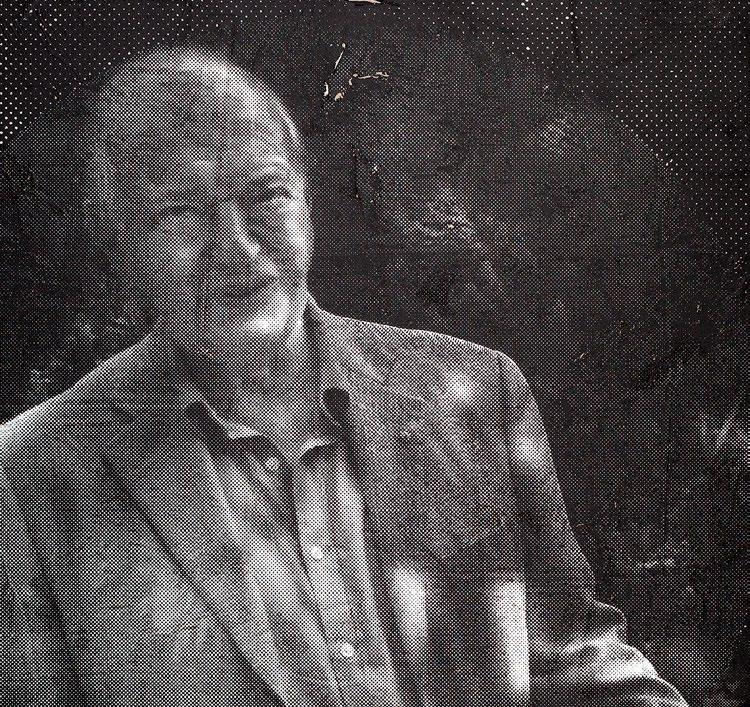
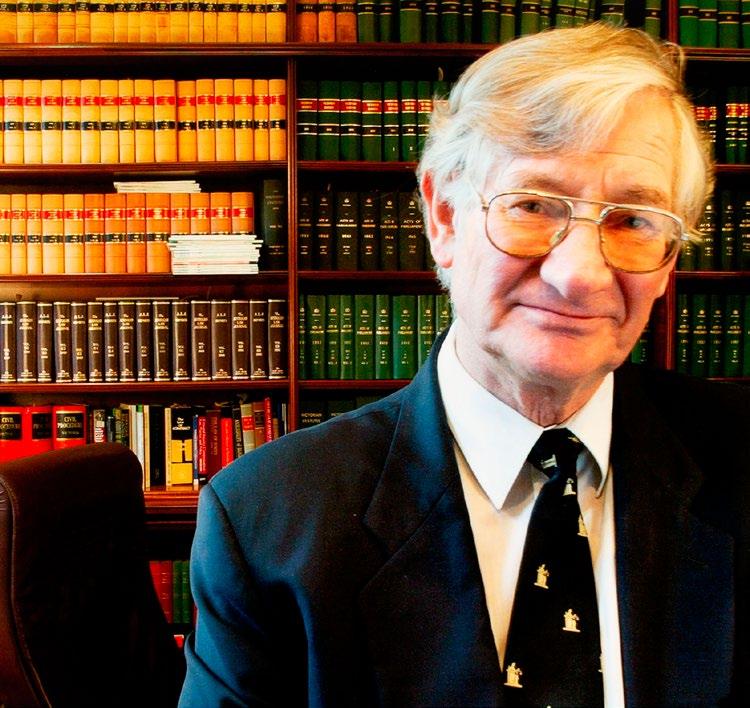


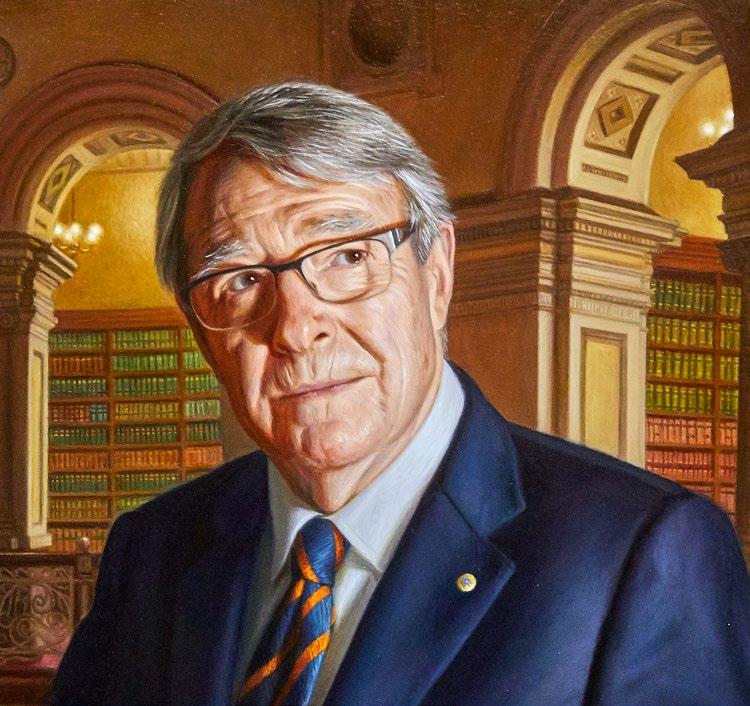


Committee as at 30 June 2020: Tony Elder (Chair), Tony Horan (Deputy Chair), Gregory Harris QC, Robert Miller, Dr Peter Condliffe, Matthew Walsh, Glen Pauline, Carey Nichol, Martin Guthrie, Adrian Muller, Cameron Charnley, Reegan Grayson Morison, Kristy Fisher.
At 30 June 2019, the committee comprised: Tony Neal QC (Chair), Tony Elder (Deputy Chair), Greg Harris QC, Marianne Barker, Carmella Ben-Simon, Dr Elizabeth Brophy, Cameron Charnley, Dr Peter Condliffe, John Hall, Tony Horan, Danielle Huntersmith, Carey Nichol & Angela O’Brien.
The Committee thanks those members who retired either during or at the end of 2019: Tony Neal QC, Marianne Barker, Carmella Ben-Simon, Dr Elizabeth Brophy, Danielle Huntersmith, and Angela O’Brien. John Hall retired but was re-appointed to the Committee during the current year.
At the start of 2020, the Committee welcomed new members: Kristy Fisher, Martin Guthrie, Adrian Muller, Matt Walsh, and Reegan Grayson Morison as the Bar Council representative. Tony Elder was appointed Chair, and Tony Horan Deputy Chair.
During the year, the Committee was assisted by, and extends its thanks, to VicBar staff, in particular Travis McKay and Jaclyn Symons.
Victorian Bar Advanced Mediator Accreditation Scheme: The Committee submitted a revised Scheme which was accepted and passed by the Bar Council at its meeting in November 2019. The promotion of the Scheme has been limited by the COVID-19 restrictions but will be taken up again when restrictions are eased.
SLEM Scheme in the Magistrates’ Court: In late 2019, the Committee worked with representatives of the Court to further develop, including the increase of the fixed fees, and publicise the referral of matters to the Single List of External Mediators (SLEM) scheme.
Continuing Professional Development: The Committee continued to host monthly discussion/de-brief sessions and conducted a number of mediation specific CPDs during the year. In October, on behalf of the Bar, the Committee jointly hosted with the Resolution Institute, a seminar on the launch of the Singapore Mediation Convention.
Victorian Bar Mediation Scheme: With the limitations on practice consequent on the coronavirus pandemic, the Committee reviewed and re-cast the Victorian Bar Mediation Scheme as an expedited scheme to enable timely referral of disputes by courts and tribunals to the Bar for mediation by nationally accredited mediator members of the Bar. The Committee approached various courts and
tribunals, including the Family Court, Federal Circuit Court, Supreme Court, County Court, Magistrates’ Court and VCAT with a draft of the expedited scheme, and has worked with representatives of the Family Court, Federal Circuit Court (both in conjunction with the Family Law Bar Association), and the County Court to develop court specific changes to that scheme. This has led to adoption of the scheme by the Family Court and Federal Circuit Court and has seen referrals of matters to the Bar for mediation. The Bar also worked with the Magistrates’ Court on a practice note for referral to mediation of all disputes with a value in excess of $40,000, on the filing of a notice of defence. This work continues and we hope to have agreement with the County Court in the near future.
Bar website: The Committee continued to work with the Bar on modifications and refinements to improve the accuracy of the information and the visibility of the Bar’s ADR capabilities and services.
International Chamber of Commerce Students’ Mediation competition: The Bar continued its sponsorship of the competition through the Henry Jolson QC prize which was presented to the winners by a representative of the Committee.
National Register of Nationally Accredited Barrister Mediators: In late 2019, the Committee obtained in-principle agreement from the New South Wales and Queensland Bars, and the Australian Bar Association (ABA), to publish on the ABA website links to each State Bar’s list of Nationally Accredited mediators.
Lawyers Certificate in Mediation Course: The fully subscribed course was to proceed in May, but due to the COVID-19 restrictions, has been postponed to November.
Law Council of Australia Mediation Accreditation Scheme: The Committee considered a proposal on behalf of the Bar from the LCA, however, before it could respond, the proposal was recalled for further consideration by the LCA.
I wish to thank the members of the Committee, members of the Bar office and President, Wendy Harris QC, for their work on the various projects addressed by the Committee during the year. With the advent of COVID-19, there has been a considerable workload in the last few months.
Committee as at 30 June 2020: Peter Jopling AM QC (Chair), Campbell Thomson, Miguel Belmar Salas, Siobhan Ryan, Charles Parkinson, Stephen Jurica, Edward (Eddy) Gisonda, Leana Papaelia, Raini Zambelli, Daniel Kinsey, Nicholas Modrzewski.
This past year saw the committee welcome new member Miguel Belmar Salas.
The committee commissioned four portraits and one bust during the course of the year and commenced fundraising for the portrait of the Hon Justice Nettle AC.
The 5 commissioned works are:
› Her Excellency the Hon Linda Dessau AC by Angela Brennan
› The Hon Ron Merkel QC by Tony Clark
› Mr Allan Myers AC QC by Sean Gladwell
› Mr Julian Burnside AO QC by Gary Summerfield
› Mr Alfred Deakin by Stephen Benwell
We also welcomed a new honorary curator, Ms Sophie Prince, on the retirement of Ms Taya Matheson and Ms Pascalle Bailey. We would like to thank Taya and Pascalle for their interest in our committee’s work. Our new curator Ms Sophie Prince has joined us with great enthusiasm and vision. Together with committee member Nick Modrzewski, Sophie has commenced a podcast conversation initiative between various artists and sitters. In the course of 2020, we hope to be able to post podcasts between the Hon Michael Black AC QC and Louise Hearman, the Hon Ray Finkelstein AO QC and Polly Borland and the Hon Sir James Gobbo AC QC and Brook Andrew. Sophie has also taken charge of our Instagram account and started posting on a more frequent basis than in the past.
During Law Week 2020, and in the midst of the pandemic our planned “In-conversation” event became a Zoom conversation. Guided by the Bar office, committee members Siobhan Ryan, Daniel Kinsey, Campbell Thomson, and myself led a discussion about the collection and specific works in the collection, namely the portraits of Joan Rosanove QC, the Hon Sir Owen Dixon GCMG SC, and Richter & Dunn.
The Gallery’s participation in PHOTO 2020, which was due to take place in April, had to be postponed due to the COVID-19 lockdown. However, the event will go ahead next year in February 2021 as PHOTO 2021 and our Gallery will show The Congo Tales suite by Pieter Henket, as planned.
Work on the Bar History Project continues apace. Peter Yule has now delivered 18 Chapters for the subcommittee’s review in accordance with his contract terms. Of interest is the author’s conclusion that the appropriateness of 1984 as the year in which to celebrate the Bar’s centenary should be questioned. Merralls and Hulme selected 1884 based on Sir Arthur Dean’s research. It was the year of the formation of the first Bar committee. Yule, with the ability to search newspapers online, has established that “the existence of The Bar was independent of any formal organisations of barristers, so it dates from either the arrival of the first barrister Edward Brewster in 1838 or the formal admission of the first five barristers by Judge Willis on 12 April 1841.” If we opt for 12 April 1841, then the Bar celebrates its 180th anniversary on 12 April 2021. A significant milestone in the life of our Bar community and the state of Victoria.
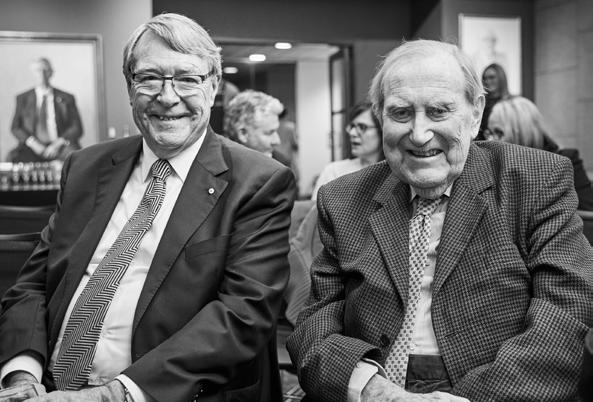
The committee is indebted to Charles Parkinson for his ongoing dedication and commitment to this project. We hope to be in a position to publish the book to coincide with the 180th anniversary in April 2021.
The committee would like to thank Daniel Kinsey, Leana Papaelia, and Nick Modrzewski for the collation of materials in the vitrines in the gallery walk area. Memorabilia associated with the Hon Jack Winneke AC RFD QC, the Hon Alan Goldberg AO QC, the Hon Sir James Gobbo AC CVO QC, the Hon Stephen Charles AO QC, the Hon Betty King QC, Julian McMahon AC SC, and Mr Max Perry have been well received by visitors and members alike. Daniel has plans for other exhibitions in the coming year.
In closing, I want to acknowledge the passing of Mr Peter O’Callaghan QC, after whom the portrait gallery is named. Peter was an active supporter of our committee and the gallery, and his portrait, by Rick Amor, gazes out with good humour on the generation of barristers who will come after him. It is a reminder too of his powerful contributions to our Bar.
Committee as at 30 June 2020: Stewart Maiden QC (Chair), Gabi Crafti (Deputy Chair), Dr Ian Freckelton QC, Meg O’Sullivan, Benjamin Murphy, Lachlan Molesworth, Katherine Lorenz (CEO), Susan Lawrence (Manager – Finance & Membership).
The Audit, Finance & Risk Committee oversees the Bar’s budget and annual reporting obligations, and monitors and maintains the Bar’s risk register. Its most important responsibility is overseeing the preparation of the budget and end of year accounts and making recommendations about them to Bar Council. In discharging its obligations, the committee liaises with the Bar’s management and its external auditors.
1 Peter O’Callaghan QC sadly passed away on 8 March 2020. The Bar extends its condolences to Peter’s family, friends and colleagues
In addition to its regular oversight activities, this year the committee reviewed the Bar’s parental leave policy and considered its cyber security report and the status of various Legal Services Board funded projects. It also assisted in revising the Bar’s updated standard form costs disclosure agreements.
Members of the Bar face unprecedented challenges with the outbreak of the COVID-19 pandemic. As a result, the committee considered and recommended significant discounts to subscription fees for 2020-21. The Bar instigated significant cost-saving measures and enrolled in government support programs at the beginning of the pandemic. Consequently, it retains reserves to assist it to support members through what will likely to be a protracted period of difficulty. While the committee has some oversight of those matters, it and the Bar are indebted to the CEO, Katherine Lorenz, and the Manager, Finance and Membership, Susan Lawrence for their extraordinary efforts in making the difficult decisions necessary to maintain the Bar’s financial stability this year. The Chair also thanks Elizabeth Ingham (Manager, Office of the CEO) for her unfailing support of the committee.
Committee as at 30 June 2020: Sam Hay SC (Chair), Katherine Brazenor (Honorary Secretary), Kieran Hickie (Assistant Honorary Secretary), Hadi Mazloum (Assistant Honorary Secretary), Adrian Finanzio SC, Minal Vohra SC, Justin Hannebery QC, Meg O’Sullivan, Sarah Keating.
The Counsel Committee welcomed three new members in November 2019: Adrian Finanzio SC, Minal Vohra SC, and Sarah Keating. The committee thanks Áine Magee QC for her excellent service from November 2015 until November 2019, initially as a member and then as Chair of the committee. It also thanks Nicole Papaleo for her diligent and committed service from November 2016 until November 2019.
The committee is appointed pursuant to clause 63 of the Constitution of the Victorian Bar. It is comprised solely of members of the Bar Council. For the purposes of making recommendations to Bar Council, it considers matters in relation to the grant, renewal, variation, suspension or cancellation of practising certificates, and applications to sign the Roll of Counsel. Additionally, the committee deals with matters relating to the removal of members’ names from the Roll pursuant to the ‘show-cause’ procedure set out in Part 14 of the Constitution.
The committee meets regularly and, since the last report, has met 10 times for general matters and held four formal hearings in relation to particular matters before it.
The Bar’s protocol for dealing with disclosures delegates to the Honorary Secretaries the role of reviewing routine disclosures made in the course of applications for renewal or grant of practising certificates, and applications to sign the Roll of Counsel, and to make recommendations directly to the Bar Council.
The 2019–2020 practising certificate renewal cycle required the review of 19 disclosures for recommendation to the Bar Council. Pursuant to the protocol, the Honorary Secretaries reviewed and made recommendations on a further six matters relating to reader applicants.
The committee has considered seven fresh matters in which there were disclosures of show cause events pursuant to s 88 of the Legal Profession Uniform Law. On 30 June 2020, two of those matters had been finalised and five are the subject of continuing investigation.
Overall, including suitability matters disclosed as part of the 2019–2020 and 2020-2021 practising certificate renewal cycles, the committee finalised 15 matters in the period from July 2019 to June 2020.
The committee is grateful for the ongoing support provided by the Victorian Bar staff and the Honorary Secretaries. In particular, the Bar’s Senior In-house Legal Counsel, Travis McKay, has continued to provide excellent support. The committee is also very grateful to have the assistance of Rachel Stelfox, In-house Legal Counsel (Regulation), who joined the Bar office in March 2020. Rachel has already dealt with a number of complicated and at times sensitive matters, and she has done an excellent job.
Committee as at 30 June 2020: Dr Oren Bigos SC (Chair), Richard Dalton QC (Deputy Chair), Minal Vohra SC, Charles Shaw SC, Darren Mort, Scott Wotherspoon, Justin Castelan, Andrew Cameron, Robert O’Neill, Premala Thiagarajan, Rachel Walsh, Myles Tehan, Paul Lamb, Xuelin Teo.
The Continuing Professional Development Committee, with the assistance of the Victorian Bar staff, has continued to oversee the CPD program, including the requirement for barristers to undertake the requisite CPD activities during the year.
This has included determining requests for accreditation of CPD activities, dispensing with the requirements of the program in respect of certain barristers, assessing exemption requests with regard to compliance with CPD requirements and dealing generally with issues raised relevant to the program.
The 2019/20 year has seen the number of CPD seminars and workshops provided to our members remain steady despite the disruption caused by the onset of the COVID-19 pandemic. The pandemic caused postponement of a number of sessions where face-to-face delivery would have been necessary, until late 2020, when it is hoped that restrictions will ease. These included the annual offerings of the Lawyers’ Mediation Certificate Course and Junior Bar Conference. The Bar associations and committees, together with Bar

Victorian Bar website: The Equality and Diversity Committee has revitalised the information available to the Bar by preparing and collating a new webpage containing information on, and links to, the Bar’s Equality and Diversity Policy; gender equality; race, ethnicity and cultural diversity; eliminating LGBTIQ discrimination; barristers with disability; barristers with family responsibilities; the Victorian Bar’s Anti-Bullying and AntiDiscrimination Policies; the various complaint procedures available for barristers; and help and counselling services.
Assistance for members with disabilities: The Equality and Diversity Committee, together with the CEO of the Bar, have set up a system for barristers and potential barristers with disabilities who have concerns or questions about their practice, or other issues relating to the Bar generally. The CEO now advertises on the Bar website the assistance she will provide in response to any such concerns or questions, including:
administration, continue to offer high quality, relevant content that covers all category areas. The education team was able to offer seminar presenters the opportunity to deliver sessions remotely using a webinar platform. It was pleasing to see the success of the new webinar program, with 23 webinars offered between April and June. This year’s program included a full-day advocacy instructor training workshop and jury skills workshop. Technology, court process developments, diversity, and health and wellbeing seminars were key topic areas. The committee provided guidance for the annual CPD audit conducted by the Bar administration.
The committee thanks retiring members Lisa De Ferrari SC, Stephen Warne, Cecily Hollingworth and Leana Papaelia for their valued service to the committee. Particular gratitude is extended to Dr Michael Rush QC for his role in the committee as a member since 2014 and as Chair since 2017.
Committee as at 30 June 2020: Jenny Firkin QC (Chair), Astrid Haban-Beer (Deputy Chair), Christopher McDermott (Secretary), Helen Rofe QC, Malcolm Harding SC, Marc Felman, Carl Moller, Haroon Hassan, Clare Cunliffe, John Maloney, Natalie Campbell.
The objective of the Equality and Diversity Committee is to promote equality and diversity at the Victorian Bar, and in the legal profession more broadly. Over the last year, the Equality and Diversity Committee has implemented many measures to achieve this aim.
Equality and Diversity Policy: The Equality and Diversity Committee substantively revised the Bar’s first Equality and Diversity Policy, introduced in 1998. The new policy outlines the Bar’s goals for promoting equality and diversity in the context of its membership, leadership and governance, and benchmarking and best practice.
› pursuing enquiries about chambers related issues;
› accommodating Bar office services, such as CPD seminars or other Bar events and functions;
› referrals to other barristers with shared experiences, to provide support and guidance; and
› addressing any issues associated with access, facilities or appearances at court.
Seminars, panels and events: The Equality and Diversity Committee has hosted a variety of dynamic events for members, the legal profession and the public generally;
› a CPD seminar titled LGBTIQ Awareness for Barristers conducted by specialist training organisation Pride In Diversity, and the LGBTIQ working group of the Equality and Diversity Committee;
› a CPD Us too? Bullying and Sexual Harassment in the Legal Profession – How is the Victorian Bar Responding? sponsored by the International Barristers Association;
› an event titled Must Love Coffee (and Know How to Zoom): The Privileges, Perils and Percolations of Life as a Victorian Barrister in the Age of COVID-19 for Law Week 2020, aimed at sharing stories and experiences of Victorian barristers from a diverse range of backgrounds, ethnicities, sexual orientations and genders;
› a Melbourne University Law School equity scholarships panel, providing an intimate discussion for scholarship students with diverse cultural backgrounds and an opportunity for them to network with a diverse range barristers;
› a cultural diversity roundtable, attended by representatives of various organisations of legal professionals with a diversity focus;
› a presentation to the September 2019 Readers’ Course on cultural and ethnic diversity considerations relating to clients, witnesses, cases and practitioners;
› its annual reengagement lunch via zoom, to bring together members of the Bar currently on, recently returned from, or planning to take, extended leave including parental or carer’s leave.
Back to the Bar flyers: The Equality and Diversity Committee has introduced a Back to the Bar initiative, which publicises the return to the Bar of our members via InBrief and in chambers’ lift noticeboards. The Back to the Bar initiative is aimed at helping members re-establish their career after parental or carer’s leave and is suitable for all members returning after a period of absence.
Cultural Diversity data: The Victorian Bar, on the recommendation of the Equality and Diversity Committee, wrote to the Victorian Legal Services Commissioner recommending the collection of cultural diversity data of Victorian barristers proposed by the Law Council of Australia (LCA). That recommendation was accepted, and cultural diversity data has been collated as part of the practising certificate renewal process.
Submissions: The Equality and Diversity Committee prepared a number of submissions over the past year, which were adopted by Bar Council, in support of equality and diversity in the legal profession:
› in September 2019: submission to the LCA Response to Discussion Paper on Sexual Harassment in the Legal Profession;
› in January 2020: submission to the LCA Response to Options Paper on Sexual Harassment in the Legal Profession;
› in April 2020: submission to the LCA Response to International Labour Organisation (ILO) Convention 190 on Violence and Harassment in the World of Work.
The Equality and Diversity Committee also supported a grant application by the Women’s Legal Service Victoria for the next phase of the ‘Starts with Us’ gender inequality project. The Bar is a consortium partner in the project.
Sexual harassment training in the Readers’ Course: The Equality and Diversity Committee made a proposal to the Readers’ Course Committee that all new members of the Victorian Bar receive sexual harassment education. This is now provided by the President of the Bar.
Cultural Diversity Court and Bar Internship: The Equality and Diversity Committee, in conjunction with the Federal and Supreme Courts, developed a cultural diversity Court and Bar internship for law students of a culturally, racially or ethnically diverse background, including those with limited connections within the legal profession and/or suffering from financial disadvantage. The internship was to be a paid opportunity to work for a week at the Federal Court, a week at the Supreme Court and a week with a barrister at the Bar. The pilot, which was suspended due to COVID-19, is ready for implementation when possible.
The Equality and Diversity Committee is grateful for the support it has received from the CEO and members of the Bar office.
Committee as at 30 June 2020: Róisín Annesley QC (Chair), Peter Chadwick QC (Deputy Chair), Andrew Strum QC, Stewart Maiden QC, Charles Shaw SC, Lisa Hannon (now SC), Fiona Ellis, James Barber, Patrick Over, Justin Wheelahan, Sarah Cherry, Paul Kounnas, Alexandra Golding, Carmen Currie, Simon Fuller
The Ethics Committee is, and has always been, comprised of experienced practitioners across all jurisdictions of practice. Members of the Ethics Committee are selected for their legal experience in their chosen practice area and for their knowledge of the regulatory framework and ethical conduct rules. Members of the Ethics Committee have always investigated complaints impartially and to the highest professional standards expected of them by the Bar Council, the Victorian Legal Services Commissioner (‘the VLSC’), members of the Bar and the community. Members have always recused themselves from sitting on an investigation where there is a conflict of interest. This exemplary service to the Bar has of course been on a voluntary basis.
In August 2019, the VLSC withdrew the delegation to the Ethics Committee to investigate complaints and undertake preliminary investigations. It is understood the VLSC’s decision to do so was based on the Uniform Law 2015 and a concern that the Royal Commission into Police Informants may make adverse findings on a system where barristers investigate complaints made against barristers. The Uniform Law 2015 nonetheless permits the VLSC to delegate powers and functions to the Victorian Bar. Complaints made against barristers are now investigated by an investigation officer, who is embedded in the Victorian Bar office, on behalf of the VLSC.
As a result of the withdrawal of the delegation, the Ethics Committee received no new investigations in the 2020 financial year. It completed and returned the single outstanding investigation which was a special delegation from the VLSC. It received and resolved one grievance. The Committee met on 12 occasions.
The Ethics Committee continued to provide the important function of giving advice and providing resolutions to barristers. The Ethics Committee provided 73 resolutions, an increase of almost 20 on the last financial year. Many of the requests for resolutions received were urgent and involved complex ethical issues, with the main area of concern being the ability or requirement to return briefs. The majority of resolutions were provided to members within 24 hours, although a number were provided in a much shorter time frame. There is a concerning and increasing trend in which barristers are receiving unacceptable abuse from clients and solicitors in the course of their practice.
This is my last report as Chair of the Ethics Committee. I have had the privilege of serving on the Ethics Committee for nine
years, three as Chair. I thank the Bar Council for their continued support of me and I particularly thank the members of the Bar who have entrusted me with their ethical issues.
One of the great strengths of the Ethics Committee is the breadth and depth of the experienced practitioners who serve on it. I am grateful to all the former Chairs under whom I served for their example and trust in me. I wish to thank and acknowledge my Deputy Chair, Peter Chadwick QC, who has been a font of sage advice, eminent sensibility, and a good friend. I thank all the members of the committee over the last 11 years for their hard work, dedication, insight and good humour.
I recognise the service of the following outgoing members: Noel Magee QC; Dr Ian Freckelton QC, Peter Rozen QC, Simon Pitt, Tyson Wodak and Eloise Dias. I especially acknowledge the work of Noel Magee QC who made a substantial contribution to the Ethics Committee over seven years and provided invaluable advice to many barristers, both through and outside the Ethics Committee.
I wish to thank Travis McKay and Jaclyn Symons of the Bar office for their hard work throughout the year and the tremendous support they provided to me and to the Ethics Committee as a whole.
The Victorian Bar is well served by the Ethics Committee, it continues to play an important role in guiding barristers as they steer the sometimes difficult course between obligations to the court, to the client and to oneself.
Committee as at 30 June 2020: Sally Flynn QC (Chair), Greg Ahern (Deputy Chair), Julie Davis, Esther James, Emily Porter, Nicola Collingwood, Banjo McLachlan, Lionel Wirth, Daniel Briggs, Matthew Meng, Dr Michael Taylor.
The Health & Wellbeing Committee thanks members who retired during the year including Mary Anne Hartley QC, Susan Borg, Bronia Tulloch, Kaye McNaught, Gemma-Jane Cooper and Roxanne Burd. The committee would particularly like to thank the former Chair, Phil Corbett QC, for his considerable leadership and contribution to the committee over the years.
Whilst the impact of the pandemic has made the work of the committee challenging, it still had a productive year including sporting activities, first aid initiatives and CPD sessions. The Bar once again made free flu shots available, which was well supported by members. The Chair of the committee, together with Bernadette Healy, continued to present to each Readers’ Course on the issues of mental and physical health, resilience, anxiety, sleep, emotional intelligence, mindfulness and achieving work/life balance. Prioritising issues surrounding physical and mental health will be subjects addressed in the CPD program for 2020/21.
The Victorian Bar Community Choir was able to thrive and quickly adapt to the challenges of the restrictions on meetings such as choir practice. The choir, led by Annemarie Sharry, was able to continue weekly sessions via Zoom, notwithstanding the challenges of having members trying to sing a song together online. Not only has there been steady attendance but there have been some lovely new voices join the choir as well.
The committee continues to oversee the barristers’ counselling service which provides both crisis and occasional counselling for barristers and members of their immediate family in times of need. Whilst Bernadette Healy of the Re-Vision Group continues to offer counselling, the Bar now offers Converge International as an alternative provider. It remains the case that five counselling sessions are offered free of charge to members with the costs being met by the Victorian Bar. These challenging times for our members highlight the need for this important health and wellbeing endeavour.
The construction of a health and wellbeing portal is the major project for 2020 and work continues to be done in conjunction with the Victorian Bar on this website. It is anticipated that the portal will be completed later this year and will contain helpful health and wellbeing resources and links specific to barristers.
Committee as at 30 June 2020: Peter Willis SC (Chair), Russell Moore (Deputy Chair), Alistair Pound (now SC) (Secretary), Tomaso Di Lallo, Susan Borg, Anthony Krohn, Adam McLean, Aggy Kapitaniak, Hugo de Kock, Andrew Yuile, Julia Kretzenbacher, Shanta Martin.
The Committee’s remit: The Human Rights Committee is one of the Bar Council’s longest standing policy advisory committees. Its task is to raise for attention issues that affect the liberty and dignity of all persons or other issues that engage human rights.
The committee’s focus is on legislation and administration, and other issues which raise systemic issues, within Victorian and Commonwealth jurisdictions. It does not address individual cases.
The committee is especially concerned with issues affecting access to justice, equality before the law, freedom from discrimination and from the arbitrary exercise of power, and adherence by government at all levels to widely accepted human rights norms, including those established by the International Conventions to which Australia is a signatory.
Lately, the committee has addressed: access to justice and legal aid; the independence of the courts and tribunals; police powers and accountability; sentencing and parole; the balance between personal liberty and intrusive state powers accumulated for counter-terrorism purposes; the rights of
children; freedom of speech and association, freedom from discrimination and freedom of religion, conscience and belief; and the treatment of asylum seekers.
Activities of the Committee in 2019/2020: The committee met regularly during the year under review in person and latterly by video-conference, as well as circulating material between meetings.
Submissions were submitted through Bar Council and the Law Council of Australia (LCA) on draft legislation, including with respect to Children Legislation Amendment Bill 2019 (Vic) and ASIO Amendment Bill 2020 (Cth) as well as contributions to relevant LCA policies and submissions.
In the course of the COVID-19 pandemic, in response to extraordinary measures of the state and federal governments, the committee has been very active and attentive to the implications of those measures for human rights and liberties. The committee urged that:
› Victoria Police and prosecutors exercise restraint, consistency and principled discretion in the issuing and enforcement of warnings and fines for alleged breaches of the directions issued under the Public Health and Wellbeing Act 2008 (Vic) and in bail matters;
› the Federal Government establish, by law specific to the COVID-19 tracking app (by Act of Parliament rather than regulation), appropriate limitations and independent public oversight measures to ensure that data gathered from the app was expressly limited as to: its period of retention; the purpose of its use; the persons authorised to have access to the data; and there be independent and effective verification of the destruction of the data at the end of that period.
The committee continued to monitor constitutional recognition of Aboriginal and Torres Strait Islander peoples; to review successive exposure drafts of a federal Religious Discrimination Bill; and the Modern Slavery Act 2018 (Cth and NSW). A Continuing Professional Development session on that Act is in planning.
Working with others: The committee has worked collaboratively with a wide range of other organs of the Bar. We thank the Bar’s policy lawyers, Jaclyn Symons, Kai Li Zhu and Travis McKay, for their work.
By way of other contributions by members of the Bar in the committee’s field, during the period under report, the late Peter Fox QC 2 , then Peter Willis SC and Shanta Martin served as member and alternate member, respectively, of the Law Council Business and Human Rights Committee.
Committee as at 30 June 2020: The Hon Robert Redlich AM QC (Chair), Paul Holdenson QC, Simon Marks QC, Daniel Gurvich QC, Justin Hannebery QC, Sam Hay SC, Sarah Keating.
The Indictable Crime Certificate (ICC) is an accreditation and quality assurance program, overseen by the Indictable Crime Certificate Committee (ICCC) on behalf of the Victorian Bar in conjunction with Victoria Legal Aid. In 2019-20 the ICCC received 15 new applications, taking the total number of received applications to 359. The 2019-20 period saw 136 ICC holders renew their certificates. A full review of the ICC accreditation scheme was launched in May 2020 to determine whether it provides suitable quality assurance and is fit-forpurpose. The final report will be presented in late 2020.
The committee is grateful to the Hon David Habersberger QC who continues to provide invaluable support to the ICC education programs and to the committee. The committee also thanks retiring committee member Wendy Harris QC for her valuable contribution to the work of the committee.
Committee as at 30 June 2020: Anne Sheehan (Chair), Timothy Goodwin (Deputy Chair), Jennifer Batrouney AM QC, Peter Willis SC, Elizabeth Ruddle (now SC), Jeremy Whelen, Justin Willee, Gordon Chisholm, Serena Armstrong, Kate Stowell.
The Bar is renewing its commitment to reconciliation. A Reconciliation Action Plan is currently under review in consultation with Reconciliation Australia.
The IJC has had increasing engagement, formally and informally, with legal organisations working with First Nations people including career options for Indigenous lawyers, advice and assistance on systemic and individual legal issues and projects.
The Indigenous Barristers Trust has been amended, bringing into its fold the Indigenous Barristers Development Fund and streamlining its procedures. The IJC remains committed to ensuring that Indigenous members of the Bar, and Indigenous lawyers considering a career at the Bar are provided with help and assistance as they establish their careers.
The Indigenous Clerkship program and the mentoring program have continued with enthusiastic support from the judges of the Federal and Supreme Courts. Three of our four Indigenous clerks completed their court experience prior to the COVID-19 lockdown. The depth of the connection that all participants in this program, students, judges and barristers cannot be overstated.
National Reconciliation Week (NRW) this year was marked with a CPD organised by the IJC and chaired by Magistrate Falla, on current legal issues affecting Aboriginal people. The
Zoom attendance broke all records for a NRW event at the Bar and included as participants, Aboriginal lawyers practising across the legal sector in Victoria.
The IJC is delighted John Heard signed the Bar roll adding to the talented Indigenous barristers at the Victorian Bar. A photo shoot of a number of former and present Indigenous barristers, as part of an ongoing RAP project, provided a unique aspect of John’s welcome to the Bar.
The IJC thanks the contributions over a considerable period of time by retiring members Campbell Thomson, Richard Wilson and Neil Howard.
Committee as at 30 June 2020: Garry Bigmore QC (Chair), Rachel Walsh (Deputy Chair), Juliet Forsyth SC, Andrew Downie, Christopher Brown, Dr Elizabeth Boros, David Kim, Angus Christophersen, Neale Paterson, Emma Poole, Gayann Walker, Liaisons: Paul Clark (BCL CEO), Daniel Calleja (BCL Liaison).
The Committee was chaired again this year by Garry Bigmore QC. It continues to strive to share and promulgate information about technology-led change in the legal sector, opportunities for barristers to use technology to their advantage in their day-to-day practices, technology changes in courts and changes to the way in which barristers may be briefed.
COVID-19 has exponentially accelerated the rate of technological change reflected in those objectives. When the committee met in the Chair’s chambers on 19 February, the lengthy agenda included a review of the positive feedback received in respect of the CPD session delivered by Juliet Forsyth SC a week earlier on Paperless Practice. That topic was recognised as one to be regularly revisited so that barristers might be inspired to gradually establish paperless practices. The impact of the virus was not anticipated.
Other topics on the February agenda were cyber-security, cloud storage, how to manage e-briefs, creating video instructions for using iPads in courts and tribunals, providing guidance in the use of PDFs, a planned CPD session on the “Wayback Machine” and the potential use of electronic platforms for mediations. No-one anticipated the use of electronic platforms for trials.
The committee’s recommendation for inclusion in barristers’ disclosure statements of a clause relating to cloud storage and security was adopted.
The committee continues to liaise regularly with Barristers Chambers Limited (BCL). Joint CPD sessions were contemplated (and hopefully will eventually occur) on topics including keeping operating systems and software up to date, using anti-virus software, making multiple secure backups of
electronic data on a regular basis, tips for identifying scam emails, using cloud services and securely sharing electronic documents with instructors, clients, experts and witnesses.
In March, the committee quickly put together the How to Work from Home Guide which remains accessible from the Health & Wellbeing tile on the member dashboard on the Bar’s website, under Resources to help you work electronically and remotely.
On 20 July, the committee promoted a CPD on Webcam Advocacy and Communication in the COVID era.
The committee is presently focussing on supporting barristers to receive only electronic briefs and to work from home.
Committee as at 30 June 2020: Philip Corbett QC (Chair), Sally Flynn QC, Remy van de Wiel QC, Hilary Bonney, Jim Shaw, Anna Robertson, Peter O’Farrell, Albert Dinelli, Emma Peppler, Erin Hill, Clare Cunliffe with assistance from Nina Massara (Education Manager) and Aylah Lohman (Senior Education Co-ordinator).
Retiring members of the committee were Trevor Wallwork, Nicholas Goodenough, Jim Doherty and Paul Kounnas. All retiring members were active participants in the work of the committee and their contribution will be greatly missed.
Since 1990, members of the Victorian Bar and judiciary have provided advocacy skills training to trainees of the Legal Training Institute (LTI), Port Moresby, Papua New Guinea and to lawyers of the South Pacific region generally. The committee continues with these activities.
In July 2019, the 19th Civil & Criminal Advocacy Workshop was conducted in Port Moresby for the Legal Training Institute over five days of intense teaching and coaching. A total of 90 trainees attended the workshop. These advocacy skills workshops have become an integral and compulsory part of the course undertaken by graduates as part of their qualification for admission to practice as national lawyers in PNG. The workshop was led by Guy Gilbert SC with administrative assistance provided by Julie Buxton. The other members of the teaching team were W. Benjamin Lindner, Anna Robertson, Brad Newton, Andrew Halse (now Magistrate), Paul Kounnas, Erin Hill and Daniel Nguyen. The Director and the staff of the Legal Training Institute consider the workshop to have been extremely successful and the Victorian Bar has been invited to participate in the LTI course in 2020 and beyond. Funding for the workshop is provided by the Australian Government Department of Foreign Affairs and Trade through the Justice Services and Stability for Development program.
Once again, the Victorian Bar was invited to present a weeklong advocacy training program for government lawyers
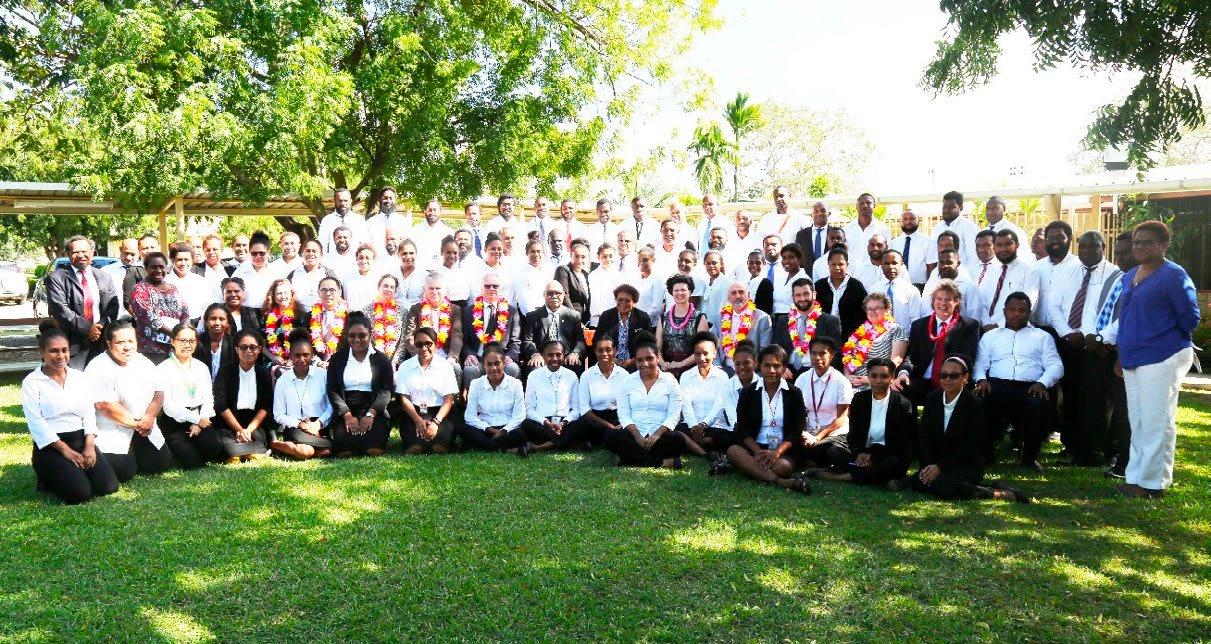
and prosecutors in the Solomon Islands. The teaching team comprised Trevor Wallwork, Remy van de Weil QC, Maya Rozner and Magistrate Suzie Cameron.
Ian Percy, a highly respected advocacy coach and senior member of the Victorian Bar delivered an advocacy training program for the legal profession of Tonga at the Law Society annual conference in December 2019. This was at the request of the Hon Michael Whitten QC, Lord Chief Justice of Tonga and was funded by the Law Society of Tonga. This was a very successful program with positive results that generated a request for further assistance for continuing professional development programs.
Invitations have been extended to the Victorian Bar to deliver advocacy training in several other South Pacific nations (Vanuatu, the Solomon Islands, Tonga and Tuvalu) in 2020, 2021 and beyond. However, the COVID-19 pandemic has put all future teaching opportunities on hold. The committee is investigating whether some of these opportunities could be delivered remotely.
The committee also co-ordinates the selection and placement of international students in the Bar Readers’ Course. Demand for places in the course for lawyers from the South Pacific has increased and is highly sought after by emerging leaders of the profession in the region. Two members of the profession from PNG participated in the September 2019 Readers’ Course and the committee, in conjunction with the Readers’ Course Committee, the International Commission of Jurists Victoria and the Federal Court of Australia trialled a pilot “International Internship” program for a practising advocate from Sri Lanka which involved the successful candidate participating in the Readers’ Course for
a two-week advocacy training component, work experience at the Federal and County Courts and mentoring by Human Rights Law advocates. It is hoped further internships can be offered to students from the Pacific and Asia in the years to come.
The committee is continually revising and updating the advocacy skills workshop content to meet the growing needs of lawyers from the South Pacific with whom the committee and teaching teams have formed close bonds. The Victorian Bar has developed and retains a strong reputation for the delivery of pro bono advocacy training in the South Pacific and 2019-2020 saw that reputation confirmed. The members of all teaching teams and the committee work hard and under difficult conditions and their work and dedication reinforces the commitment of the Victorian Bar to pro bono legal education and advocacy training in the region.
Committee as at 30 June 2020: Martin Scott QC (Chair), Gregory Harris QC, Jeremy Twigg QC, Darren Mort, Eugenia Levine, Elle Nikou Madalin, Raini Zambelli, James Waters, Amy Hando, Huw Watkins.
For some years the International Arbitration Committee has worked towards establishing chambers for members of the Victorian Bar in Singapore, recognising the importance of that country for international arbitration. Considerable effort has been dedicated to this task by several members. Members of the committee also forewent the opportunity to participate in private chambers in Singapore with a view to supporting a vital strategic initiative for the benefit of the Bar more broadly.
The committee’s work was complete when it secured sufficient confirmations of interest (from across both the Bar and other independent Bars) for the venture to be financially self-supporting and had the support of Maxwell Chambers for the Victorian Bar to take a lease over a room. A fitout had been specified and the necessary documentation prepared and executed by the participants.
I record my gratitude to all those who made this remarkable achievement possible, including Mark Dempsey SC (among others) who joined our Bar in support and went to considerable efforts to make it happen.
I also record my gratitude to the more than 20 pioneering colleagues who formally committed to the chambers, in particular those who passed up other opportunities. It is fair to describe them as being in the vanguard of forward-thinking and exemplars the collegiate spirit of the Bar in a tangible way that is all too rare. Their actions speak volumes to me and should be recognised.
Regrettably, the venture was not ultimately supported by Bar Council and did not therefore proceed.
Otherwise, the committee has made submissions to ACICA on procedural innovation and supported a new initiative by Robert Heath QC to promote and develop skills in small domestic arbitrations. This is a vital initiative because it will provide an opportunity for members of the Bar to cross the threshold of publishing sufficient awards to apply for institutional panels in arbitration centres such as Singapore.
Committee as at 30 June 2020: Mark Robins QC (Chair), Dr Paul Vout (now SC) (Deputy Chair), Andrew Burnett (Secretary), Helen Rofe QC, Richard Brear, Mark Campbell, John Gordon, Jonathan Wilkinson, Nawaar Hassan, Lucy Line, Ray Ternes.
The Library Committee thanks the members who retired during the year, namely Ian Upjohn CSC QC (former chair) and Melanie Baker.
The Bar Library’s integration with the Law Library of Victoria (LLV) continues to bring considerable benefits to the Bar. Prior to the COVID-19 lockdowns, members were making increasing use of the three computer terminals in the Richard Griffiths Library to access to the LLV’s expanding digital collection. In April 2020, the LLV launched a specific online digital access service for use by Bar members, lawlibrary.vic.gov.au/barristers, securing considerable additional valuable search materials at no cost for barrister users. Further titles have been added to this service through the tireless service of the LLV, its Director and her staff as a vital online research tool for barristers working from home.
In late 2019, an instructive CPD seminar entitled Beyond Austlii was presented by Dr Paul Vout (now SC), Vice Chair
of the Committee, with Belinda Schembri, Library Reference Services Coordinator, and Renee Naylor, Reference Librarian of the LLV/Supreme Court Library. Further plans for future CPD presentations in 2020 were regrettably placed on hold pending resolution of the COVID-19 restrictions in Melbourne.
Mark Robins QC, Ian Upjohn CSC QC and Nawaar Hassan attended the LLV Strategic Planning Workshop held on 30 January 2020, together with Justices Garde and Moore, the Director of the LLV and numerous representatives of user groups of the LLV. Following from this meeting a draft strategic plan for the LLV was circulated, and further comments were provided by Mark Robins QC to that draft. This ambitious plan focuses to maximise online access to the LLV’s digital resources. This was a particularly timely initiative given the events in Victoria since March 2020.
In June 2020, with the support of the LLV staff, and in particular Belinda Schembri, additional texts were acquired for the Richard Griffiths Library. Although the consensus of the committee was clearly to favour digital acquisitions where possible going forward, the Legal Publishers’ pricing strategies for multiple user digital licences made such acquisitions impossible. A subcommittee has been formed to identify digital texts which might be economically acquired for the 2021 year, although the economic difficulties faced are very real.
Otherwise, Bar members continue to make very kind donations of textbooks and monographs which they have written and to offer reports, journals and volumes from their own libraries upon retirement or downsizing. Particular thanks this year goes to Dr Paul Vout (now SC).
Committee members have worked tirelessly throughout the year attending meetings, more latterly remotely. Members have variously participated in workshops conducted by the LLV on improving access by the legal profession to the LLV digital collection. The committee looks forward to progressing this into 2021 and beyond.
Detailed notes of the damage to parts of the collection kept in the Bar Council Chamber as a result of the ‘great flood’ of December 2018 have been made and maintained by Richard Brear, who was instrumental in saving scores of volumes at the time. Consideration continues to be given to the desirability and scope (if any) for funding the repair and/or replacement of seriously damaged volumes.
The lawlibrary.vic.gov.au website has a full catalogue of electronic and hard copy resources, which identifies the Bar Library’s hard copy holdings. The Bar Library page on the Bar’s website has library policies and procedures and identifies library committee members who welcome your questions and suggestions. A hardcopy of catalogue of the LLV’s Electronic Collection and exclusively hard-copy reports is kept in a folder in the RGL.
Committee as at 30 June 2020: John Leung (Chair), Daniel Diaz (Secretary), Nico Burmeister, Andrew Burnett, Scott Davison, Reegan Grayson Morison, Andrea de Souza, Alan Ford, Rabea Khan, Felicity Fox, Nicholas Bird, Nick Mutton, Tim Glass.
The New Barristers Committee thanks those members who retired from the committee during the year: Timothy Dowling, Fleur Shand, Daniel Nguyen, Matthew Meng, William Barker and Lucy Dawson.
In October 2019, the committee undertook a survey of new barristers in relation to demographics, CPD and social events for new barristers and health and wellbeing. This survey yielded a number of significant findings which have been reported to the Bar Council. The findings also have greatly informed the committee’s program for 2020.
The committee has continued to undertake its program of CPD and social events for new barristers. Due to COVID-19, the committee’s program has largely been taken online and those events have been very well attended and received.
In relation to CPD events, in the latter part of 2019 the committee hosted an event on tax and accounting for new barristers and this year an online session in relation to building a practice. Further events are planned for the second half of 2020, with a focus on practice building and advocacy. The committee thanks all speakers who gave up their time to speak at CPD events.
In relation to social events, the committee hosted a number of casual networking coffees between new barristers and silks and senior juniors in the second half of 2019. This initiative was continued virtually in 2020. Both sets of events were well attended and the committee thanks senior counsel and senior juniors involved in the events. The committee also co-hosted an online trivia event with the Young Lawyers section of the Law Institute of Victoria in the first half of 2020. Finally, continuing from 2018, the committee hosted an end of year dinner event for new barristers in December 2019. The committee will seek to continue this new tradition in 2020 whether in the usual way or virtually.
In response to the COVID-19 crisis, the committee has established an online Slack forum for new barristers to encourage collegiality between new barristers virtually.
The committee has been represented nationally at the Australian Young Lawyers committee of the Law Council of Australia.
Finally, the committee has continued to speak to March and September readers, fielding questions about what the new barristers can expect in the first year of practice.
The committee is grateful for the on-going support it receives from the judiciary, senior members of the Bar, the Bar Executive and the Bar administration, including the Education and Policy team.
Committee as at 30 June 2020: Meredith Schilling (Chair), Michael Rivette (Deputy Chair), Dr Ian Freckelton QC, Donald Farrands (now SC), Tom Danos OAM, Richard Wilson, Nicholas Kanarev, Meg O’Sullivan, Adam Coote, Eugenia Levine, Dr Laura Hilly, Willem Drent, Alexia Staker, Christopher Lum, Anna J O’Callaghan, Bonnie Renou.
The Pro Bono Committee supports the longstanding tradition of barristers performing work pro bono publico by overseeing the Bar’s various pro bono schemes. Pro bono work performed by barristers under the schemes helps improve access to justice for clients, promotes the rule of law and supports the administration of justice in our courts.
The schemes operate under two models. First, the Victorian Bar Pro Bono Scheme (the VBPBS) facilitates pro bono legal services to the general community. Justice Connect administers the VBPBS on behalf of the Bar, triaging requests for assistance from the broad community and coordinating referrals to suitable barristers and law firms. Secondly, the various court referral schemes facilitate pro bono services for self-represented litigants in cases that are already before courts. These schemes currently operate in the Victorian Supreme Court and Court of Appeal, the County Court and the Coroners Court, under protocols which have been developed collaboratively with each court and which identify the types of matters which may be suitable for referral to the Bar for pro bono assistance, and the procedures governing such referrals.
The committee has continued its work in 2020, meeting remotely to adapt to the restrictions caused by the COVID-19 pandemic. Pro bono achievements during the past year include the following:
Pro Bono Platform: The Victorian Bar’s new online Pro Bono Platform went ‘live’ on 10 June 2020, following a formal launch in late 2019 by the Attorney-General of Victoria, the Hon Jill Hennessy MP. The platform revolutionises the way in which pro bono referral requests can be made under the court referral schemes, by enabling court users to input requests for pro bono assistance directly into the platform. Those requests are then circulated automatically to barristers with experience in the relevant practice area (or an interest in accepting pro bono work in that area), who can accept the referral online. The platform is the next evolution in the Bar’s long and proud history of pro bono work and will improve the efficiency of the court referral schemes, as well as providing a simple and transparent method for barristers to engage in pro bono work. The pro-bono committee was closely involved in the development of the platform – with a sub-committee, chaired by Meg O’Sullivan, working intensively with Victorian Bar staff and the developer, Icon Agency, on the platform’s content.
Pro Bono video: Throughout 2019, committee member Michael Rivette and a sub-committee chaired by Michael
worked on a production of a short film showcasing the Bar’s commitment to pro bono work and the difference it can make in the lives of clients. The finished product, which was formally launched in conjunction with the launch of the platform, told the moving story of mother and daughter Betty and Maria, whose loss of their home to arson affected their participation in the criminal legal process, but who succeeded in their appeal to the Victorian Supreme Court with the help of two Victorian pro bono barristers. The video is now a permanent feature of the Bar’s pro bono webpage.
Pro Bono template costs agreements: Committee member Christopher Lum chaired a sub-committee tasked with developing a series of template costs agreements for use in pro bono matters. The rules surrounding costs recovery in pro bono matters are complex and vary between jurisdictions. The new templates, which were completed and uploaded to the Bar’s pro bono webpage in early 2020, will provide an invaluable resource for barristers undertaking pro bono matters in the future.
Coroners Court Pro Bono Scheme: In June 2019, a newly established pilot scheme with the Coroners Court was launched. Following the successful completion of the pilot in June 2020 a new protocol has been established with the Coroners Court, providing for ongoing referral of pro bono requests and an expansion of the scheme categories beyond those included in the pilot. Committee member Michael Rivette chaired the sub-committee overseeing the review of the pilot scheme.
Monash pilot pro bono assistance scheme: In 2020 the committee has commenced discussions with Monash University Law Faculty with a view to establishing a pilot pro bono student assistance scheme. It is envisaged that under the scheme, students will volunteer to assist barristers in pro bono matters. The project, which has an anticipated launch date of semester 1 2021, is being spearheaded by committee members Dr Laura Hilly and Willem Drent.
CPDs: In June 2020, the committee hosted a CPD on the new pro bono platform, presented by Daniel Cousens, Victorian Bar Digital Communications Coordinator. The presentation, which was held remotely, was an opportunity for barristers to familiarise themselves with the new platform.
› In July 2020, the committee co-presented a very successful CPD in conjunction with the Commercial Bar. Titled Pro Bono – not just public law, the CPD involved a panel of eminent judges who spoke about the value of pro bono to the courts and the breadth of pro bono opportunities in areas of commercial law. The panel included Justice Bromberg from the Federal Court, Justice Peter Almond from the Victorian Supreme Court and Judge Ted Woodward from the County Court. The panel also included commercial silk Michael Gronow QC, winner of
the 2019 Victorian Bar Trophy for exceptional individual achievement in pro bono advocacy over a long period. This CPD was co-chaired by Claire Harris QC and committee member Meredith Schilling and was superbly organised by committee members Eugenia Levine and Anna O’Callaghan.
› A further CPD session was presented about Pro bono at the Bar, to the March 2020 Bar Readers’ Course. Committee members Meredith Schilling and Meg O’Sullivan gave these presentations to new readers, alongside a representative from Justice Connect.
The committee acknowledges the outstanding leadership of Richard Wilson, who retired as Chair at the end of 2019, but who has remained a member of the committee in 2020.
Committee as at 30 June 2020: Dr Suzanne McNicol AM QC (Chair), Eugene Wheelahan QC (Deputy Chair), the Hon Raymond Finkelstein AO QC, Michael Borsky QC, Anthony Strahan QC, Dr Michael Rush QC, Justin Graham (now SC), Ben Ihle (now SC), Sarah Porritt, Ben Gibson, Aphrodite Kouloubaritsis, Kathleen Foley, Diana Price, Lachlan Cameron.
During the last year the Readers’ Course Committee (RCC), first chaired by Simon Marks QC, then by Dr Sue McNicol AM QC from February 2020, has continued to oversee the form and content of the readers’ course and the Bar exam in accordance with the Bar’s Application & Reading Regulations. This has been done in close consultation with Victorian Bar staff.
An important task undertaken this year was a refresh of the Bar readers’ course. In November 2019, the RCC Chair appointed the Course Review Working Group, comprising of the Chair, Simon Marks QC, Vice-Chair, Dr Sue McNicol AM QC, Dr Michael Rush QC, Justin Graham (now SC) and Fleur Shand to review the current readers’ course program and to make recommendations to the committee as to how, within the existing course framework, the course could be improved, refined or otherwise modified (to eliminate overlap, improve time and operational efficiency and otherwise enhance the course), for implementation in the March 2020 course. The recommendations were accepted by the committee and the refinements to the course were introduced in March 2020. A differently constituted Course Review Working Group, comprising Dr Sue McNicol AM QC as Chair, Eugene Wheelahan QC as Vice-Chair, Ben Ihle (now SC), Aphrodite Kouloubaritsis and Diana Price, continues to review and advise on course content for the September 2020 readers’ course.
The unexpected onset of the COVID-19 pandemic resulted in significant disruption to the course with all face-to-face course delivery ceasing after 24 March 2020. The committee worked closely with the Bar education team to deliver a modified course by remote means. The modified course was successfully delivered with the cohort signing the Bar Roll of Counsel as

VICTORIAN BAR OCTOBER 2019 READERS (BACK ROW L-R): Johann Ollquist, Eva Weiss, Katherine Wangmann, Vivienne Jones, Kylie Jeans, Mitchell Brogden, Nicole Menegas, Sonari Fernando, Luke McPhie, Nicholas Mutton, Ryan Hartshorne, James Eley, David Mence, Geoffrey Smith, Bonnie Renou (MIDDLE ROW): Aylah Lohman, Karan Raghavan, Ryan Kornhauser, Ella Delany, Jacqui Hession, Rebecca Koralyo, Bethany East, Ganesh Jegatheesan, Paul Annabell, Christopher Hibbard, Joel Tito, Kathy Karadimas, Timothy Harvey, Thomas Crouch, Morgana Brady, Joel Phillips, Charles Morshead, Benjamin House, Martin Radzaj, Angelo Bartzis, Nina Massara (FRONT ROW): Matthew Gledhill, Rutendo Muchinguri, Toni Stokes, Daye Gang, Holly Jager, Kay Chan, Tahlia Ferrari, Karen Mak, Justin Lipinski, Therese Borger, Mihal Greener, Amanda Ila, Lauren Burke, Sally Buckley.
planned on 7 May 2020 in a virtual signing ceremony. With the disruption likely to continue for the remainder of the year, these developments and modifications will be carried into a planned hybrid delivery of the course for the September 2020 cohort.
The International Internship Program Pilot developed last year, was successfully launched in August 2019. This program provided one international applicant with an opportunity to secure an in-depth understanding of the administration of justice in Victoria, through a placement program run by the Victorian Bar with assistance from the International Commission of Jurists (ICJ), the Federal Court and the County Court. The applicant, Mr Collin Andrew, a practising solicitor from Malaysia, spent five weeks in Melbourne undertaking parts of the readers’ course, watching sitting judges in the Federal and County Courts and with a mentor barrister at the Bar. The program was very successful with the candidate providing very positive feedback and the committee commending the program to become a regular annual offering.
The September 2019 readers’ course accommodated 48 readers including two overseas readers from Papua New Guinea. The March 2020 course accommodated another 48 readers, all of whom have now joined our Bar. The committee congratulates each of them and wishes them well in their careers. The committee is most grateful to the Victorian Bar staff for its work in coordinating the course, to the many volunteers (including judges and barristers) who, each course, give of their time to present seminars, conduct advocacy workshops, undertake assessment tasks and other work in and around the course. Without their involvement, the Bar could
not conduct the current course program. The committee is particularly grateful to the Director of Trial Advocacy, Andrew Palmer QC and to the advocacy team, who work tirelessly to make Advocacy Week the success that it is.
The Bar continues to attract great interest within the profession as a vocational destination. 142 candidates sat the October 2019 exam. 57 candidates received offers to undertake the readers’ course. These candidates have been placed in either the March 2020 or September 2020 course. The administration of the exam and the readers’ course continues to present the committee with significant challenges. With both courses filled after the October exam, the committee recommended that only one exam be run in late 2020 for course placements in 2021. For the first time, the Bar will be delivering an electronic exam in accordance with the recommendations of the 2019 Exam Review Panel report to Bar Council.
The committee acknowledges and thanks retiring committee members Adrian Finanzio SC, Justice Lisa Nichols and Christopher Tran for their valued service and commitment to the work of the committee and the Bar. The committee would like to extend particular thanks to Simon Marks QC, former Chair and member of the committee since 2014.
Committee as at 30 June 2020: Zubin Menon (Co-Chair), James Waters (Co-Chair), Kess Dovey (Co-Secretary), Sebastian Reid, Shaun Ginsbourg, Simon Pitt, Robert O’Neill, Daniel Nguyen, Monika Furman, Tim Farhall, Veronica Holt, Bonnie Renou.

(ROW 6): Andrew Norris, James (Jimmy) Ryan, Manuel Puyol, Priya Wakhlu, Lachlan Howe, Lisa Andrews, Nicolas Dour, John Heard
The work of the Student Engagement Committee continued strongly notwithstanding the multiple challenges which public health restrictions placed upon the usual operation of our shadowing and events programs. Prior to those restrictions coming in to play, committee member Simon Pitt continued our high school outreach program with a visit to Balwyn High School to participate in an interactive session with students about the role of a barrister in the modern legal landscape.
However, as restrictions hit, the committee pivoted away from some of our usual projects (such as our Law Week productions) and shifted towards new ways to deliver meaningful content to university students through webinars. Committee members including Co-Chair James Waters, Sebastian Reid, Shaun Ginsbourg, Daniel Nguyen, Monika Furman, Tim Farhall, Veronica Holt and Bonnie Renou all participated as panellists on webinars presented to law students from Australian Catholic University, Victoria University, Deakin University and La Trobe University. The committee also extends thanks to Katherine Brazenor and Julia Kretzenbacher, who gave up their time to be panellists and share their insights about life at the Bar.
These webinars were essential to providing meaningful content to law students who have experienced a disrupted year. Our webinars are designed to support the strategic plan of the Bar: the committee believes that part of our role is to ensure that law students understand the importance of the Bar as a public institution and why an independent and diverse Bar is essential to protecting rights, resolving disputes and
demanding accountability in a modern society. The feedback from the students has been excellent and they particularly enjoyed being able to ask questions and hear about the diverse range of journeys to becoming a barrister. Moving forward, the committee intends to use webinars as a powerful tool for reaching a wider student audience. It sits well alongside our existing social media tools, managed by Bonnie Renou, which continued to receive good traffic.
The committee has begun planning for 2021 to ensure the next committee has the foundations to continue working effectively. We have reviewed and amended our Charter to reflect more clearly the aims and work of each of our subcommittees. We have also established strong relationships with Deakin University, La Trobe University, Monash University and Victoria University to support running several shadowing programs next year. The new shadowing program will use partnerships with law schools to give groups of students an opportunity to shadow a barrister for five days over a five-week period. In addition to the shadowing component, students are offered a tour of the legal precinct, a presentation by the Juries Commissioner and the opportunity to partake in a shortform mooting competition. Committee member Tim Farhall is working with the Bar’s Pro Bono committee and Monash University to design and implement a pro bono program for students. The committee is excited to support this excellent proposal. Finally, the committee also extends thanks to Benjamin Halstead, our student administrator. His assistance over the first half of this committee’s term was invaluable.

Committee as at 30 June 2020: Justin Wheelahan (Editor), Annette Charak (Editor), Natalie Hickey (Editor), Carmella BenSimon, Campbell Thomson, John Tesarsch, Tony Horan, Maree Norton, Temple Saville, Brad Barr, Jesse Rudd, Hadi Mazloum, Shanta Martin (Editorial Board), Veronica Holt.
In 2019-2020, the Victorian Bar News committee continued to create a biannual magazine for members of the Bar and Bench.
The summer issue was themed ‘the power of community’, taking a broad look at the ways in which we tell stories, speak our minds and help each other. The importance of Bar News as a pillar for maintaining community became increasingly
evident in the preparation of the winter issue, as we found ourselves more physically scattered than ever. We recognised that the winter issue would be historically significant and used the magazine to document this moment for posterity, with a broad view of life and its challenges in lockdown.
The purpose of Bar News is to inform readers of various activities around the Bar, to showcase the diversity and range of talent of its members, to inspire debate and discussion about matters of interest to barristers and the legal profession, and to record the story of the Bar and its members. The Bar News Committee is assisted by Denise Bennett, Amanda Utt from the Bar office, copy editor Peter Barrett, and Guy Shield who deals with layout, illustrations, design, typesetting and the look and feel of the magazine. Southern Colour is responsible for final production.

The Bar congratulates members appointed to Public, Judicial and other Office:
Supreme Court of Victoria
Court of Appeal
The Honourable Justice Michael Sifris
Trial Division
The Honourable Justice Lisa Nichols
The Honourable Justice Christopher James Delany
The Honourable Justice Kathryn Stynes
County Court of Victoria
His Honour Judge Arushan Pillay
Her Honour Judge Rosemary Carlin
His Honour Judge Kevin Doyle
Her Honour Judge Anne Hassan
Her Honour Judge Fran Dalziel
Her Honour Judge Sarah Leighfield
His Honour Judge David Purcell
Her Honour Judge Fiona Todd
Her Honour Judge My Anh Tran
His Honour Duncan Allen QC – Reserve Judge
Lord Chief Justice of the Kingdom of Tonga
Michael Whitten QC
Chair of Victoria Law Reform Commission
The Hon Anthony North QC
Magistrates’ Court of Victoria
Her Honour Chief Magistrate Lisa Hannan
Her Honour Magistrate Hayley Bate
His Honour Magistrate Justin Foster
His Honour Magistrate Michael Richards
Her Honour Magistrate Elizabeth Langdon
Her Honour Magistrate Kristen Rose
Her Honour Magistrate Victoria Campbell
His Honour Magistrate Andrew Halse
Her Honour Magistrate Helen Murphy
Coroners Court of Victoria
His Honour Coroner John Olle
Victorian Civil and Administrative Tribunal
John Billings
Kim Knights
Neill Campbell
Holly Nash
Commissioner of Essential Services Commission of Victoria
Sitesh Bhojani
Victoria State Government - LGBTIQ Justice
Working Group
Christine Haag
Law Aid
(Victorian Bar Incorporated and Law Institute of Victoria)
Christopher Blanden QC
James Mighell QC
Michelle Britbart QC
Fiona Ryan
Medico-Legal Joint Standing Committee
Tim Tobin SC
Mary Anne Hartley QC
Paul Halley
Australian Bar Association
Board of Directors
Matthew Howard SC (President), Dr Matthew Collins AM QC (Vice-President) and Wendy Harris QC (Director)
Committees
Criminal Law Committee
Amelia Beech, Zoe Broughton, Ffyona Livingstone Clark, Zubin Menon and Paul Smallwood
Diversity & Inclusion Committee
Ffyona Livingstone Clark
Ethics Committee
Rowena Orr QC – Chair, Dr Michael Rush QC, Patrick Doyle and Maree Norton
Law Council of Australia
Directors
Justin Hannebery QC
Committees and Working Groups
Advisory Committees
Dr David Neal SC, Peter Fox QC, Peter Willis SC, Jenny Firkin QC, Nicholas Cowdery AO QC, Simon Molesworth AO QC, David Parsons SC, David Grace QC, Paul Holdenson QC, Michael Stanton, Alan Ford, Emrys Nekvapil, Shanta Martin and Laurence White
Legal Practice Section - Committees
Jennifer Batrouney AM QC and Michael Heaton QC
Family Law Committee
Andrew Strum QC
Indigenous Issues Committee
Thomas Keely SC and Anne Sheehan
International Committee
Michael Whitten QC, Paul Hayes QC, Stewart Maiden QC and Raini Zambelli
Tax Committee
Jennifer Batrouney AM QC, Daniel McInerney (now SC), Angela Lee and Kateena O’Gorman
Commonwealth Courts and Tribunals
Federal Court of Australia
Class Action User Group
Charles Scerri QC, Wendy Harris QC, Bernard Quinn QC and Lachlan Armstrong QC
Corporations and Commercial NPA User Group
Michael Borsky QC, Stewart Maiden QC, Anthony Strahan QC, Cam Truong QC, Dr Oren Bigos SC, Greg Ahern, Alison Umbers and Raini Zambelli
Employment & Industrial Relations NPA User Group
Craig Dowling SC
Insolvency (Bankruptcy and Corporate Insolvency) User Group
Philip Corbett QC, Michael Gronow QC, Carl Moller and Charles Parkinson
State Courts and Tribunals
Supreme Court of Victoria
Arbitration Users’ Group
Hugh Foxcroft QC
Chief Justice’s Rules Committee
Jonathon Moore QC
Corporations and Commercial Court User Group
Intellectual Property Users’ Group
David Shavin QC, Helen Rofe QC and Tom Cordiner QC
Migration User Group
Georgina Costello SC, Nick Wood, Angel Aleksov and Sarah Zeleznikow
Pro Bono Working Group
Richard Wilson, Catherine Symons, Eugenia Levine, Angel Aleksov, Sarah Zeleznikow, Willem Drent and Lachlan Molesworth
Users Committee
Garry Bigmore QC, Charles Scerri QC, Helen Symon QC and Frank O’Loughlin QC
Business Law Section – Committees
David Shavin QC, Jennifer Batrouney AM QC, George Golvan QC, Philip Crutchfield QC, Frank O’Loughlin QC, Renee Enbom SC, Carl Moller, Angela Lee and Dr Elizabeth Boros
Family Law Section – Executive Committee
Minal Vohra SC
Federal Litigation Section – Committees
David Shavin QC, Paul Willee RFD QC, Georgina Costello SC, Frank O’Loughlin QC, Tony Nolan QC, Stephen Moloney and John Wallace
Garry Bigmore QC, Philip Crutchfield QC, Philip Solomon QC, Michael Galvin QC, Lachlan Armstrong QC, Penelope Neskovcin QC, Dr Oren Bigos SC, Anton Trichardt, Carl Moller, Simon Rubenstein, Catherine Gobbo and Joshua Kohn
Legal Costs Committee
Stewart Maiden QC
Dust Diseases Users’ Group
John Gordon and Patrick Over
Judicial Review and Appeals Users’ Group
Peter Hanks QC, Dr Ian Freckelton QC, Michael Fleming QC,
Jason Pizer QC, Christopher Horan QC, Lisa De Ferrari SC, Ben Ihle (now SC), Rachel Ellyard, and Emily Latif
Law Library of Victoria Committee
Dr Paul Vout (now SC) and Nawaar Hassan
Personal Injury User Group
Ross Gillies QC, Timothy Tobin SC and David Martin
Probate Users’ Committee
Richard Boaden
Property Law List User’s Group
Matthew Townsend, David Lloyd and Leana Papaelia
TEC List User Committee
Hugh Foxcroft QC
Victorian Valuation, Compensation and Planning Users’ Group
Christopher Canavan QC, Christopher Wren QC, David Batt QC, Adrian Finanzio SC, Jason Pizer QC, Nicholas Tweedie SC, Marita Foley SC, Matthew Townsend, Sarah Porritt, Paul Chiappi and Peter O’Farrell
County Court of Victoria
Bench Bar Working Group Committee
Daniel Gurvich QC, Ian Hill QC, David Hallowes SC, Colin Mandy SC, Cynthia Lynch and Pardeep Tiwana
Building Cases List Users Group
Romauld Andrew, Victoria Blidman, Adam Rollnik and Kylie Weston-Scheuber
Commercial Division Users Group
Michael Gronow QC, Jeremy Twigg QC, Peter Lithgow, Con Salpigtidis, Catherine Gobbo, Andrew Downie and Georgia Berlic
Cost Review Committee
Timothy Tobin SC and Sam Hay SC
Magistrates’ Court of Victoria
Alternative Dispute Resolution Committee
Carey Nicol and Cameron Charnley
Civil Rules Committee
Frank Ravida
Statutory Appointments
Legal Services Board
Jennifer Batrouney AM QC (Advocate elected member)
Representatives on Educational Bodies
Melbourne Law School Advisory Council
Jennifer Batrouney AM QC
Melbourne Law School Tax Masters Advisory committee
Jennifer Batrouney AM QC, Frank O’Loughlin QC, Catherine Symons and Mia Clarebrough
Victoria University Sir Zelman Cowen Centre Advisory Committee
Brind Zichy-Woinarski QC
Other Bodies
ACICA Board
Martin Scott QC, Mark Dempsey SC and Caroline Kenny QC
ATO Public Advice and Guidance Panel
Jennifer Batrouney AM QC
Australian Bar Review - Editorial Board
Michael Gronow QC
Charity Law Association of Australia & New Zealand
Jennifer Batrouney AM QC
Criminal User Group
Daniel Gurvich QC, Simon Moglia and Pardeep Tiwana
Family Property Division List Committee
Carolyn Sparke QC and Graham Robertson
County Court Rules Committee
Georgina Coghlan (now SC) and Michael Corrigan
Sex Offence List User Group
Simon Moglia
WorkCover Users’ Group
Robin Gorton QC and Ian McDonald SC
Civil Practice Committee
Steven Lowry
WorkCover Users’ Group
Kim Bradey and Megan Cameron (nee Tait)
Legal Services Council – Admissions Committee
Dr Elizabeth Boros
Monash University Centre for Commercial Law and Regulatory Studies - CLARS External Advisory board
Dr Oren Bigos SC, the Hon Ray Finkelstein AO QC, Ian Horak and Dr Warwick Rothnie
Monash University Dean of Law’s External Professional Advisory Committee
Paul Willee RFD QC
Competition & Consumer Law
Daniel Clough, Alice Muhlebach and Tim Farhall
Council of Law Reporting
Michael Pearce SC
Fair Work Commission Termination of Employment
User Group
Yasser Bakri and Rebecca Preston
Firearms Appeals Committee
Alexandra Burt (Chair) (now Magistrate)
Other Bodies (continued)
Heritage Council of Victoria
Adrian Finanzio SC
Justice Connect
Richard Wilson
Law Institute of Victoria
- Tax Specialist Accreditation Advisory Committee
Frank O’Loughlin QC
Legal Practitioners Liability Committee Board
Adrian Finanzio SC
Legal Super Pty Ltd
Philip Kennon QC
Mediator Standards Board - Board of Directors
Peter Condliffe
Takeover Panel
Michael Borsky QC
The Victorian Assisted Reproductive Treatment Authority (VARTA) – Board member
Nicole Mollard
The Victoria Legal Aid - Collaborative Planning Committee
Simon Moglia
Victoria Law Foundation Board
Peter Caillard
Victorian Law Reform Commission
Ross Gillies QC
Victorian Legal Admissions Board
The Hon David Habersberger QC - Deputy Chair, Dr Suzanne McNicol AM QC and Magda Karagiannakis
Victorian Legal Admissions Committee
The Hon David Habersberger QC, Jennifer Batrouney AM QC, Ian Waller QC, Samuel Hay SC, Magda Karagiannakis, Nicholas Green QC and Lisa Hannon (now SC)
Victorian Legal Admissions Academic Course Appraisal Committee
Dr Elizabeth Boros (Chair), Dr Jason Harkess and Magda Karagiannakis
Victorian Workcover Authority committee
Robin Gorton QC (Chair)

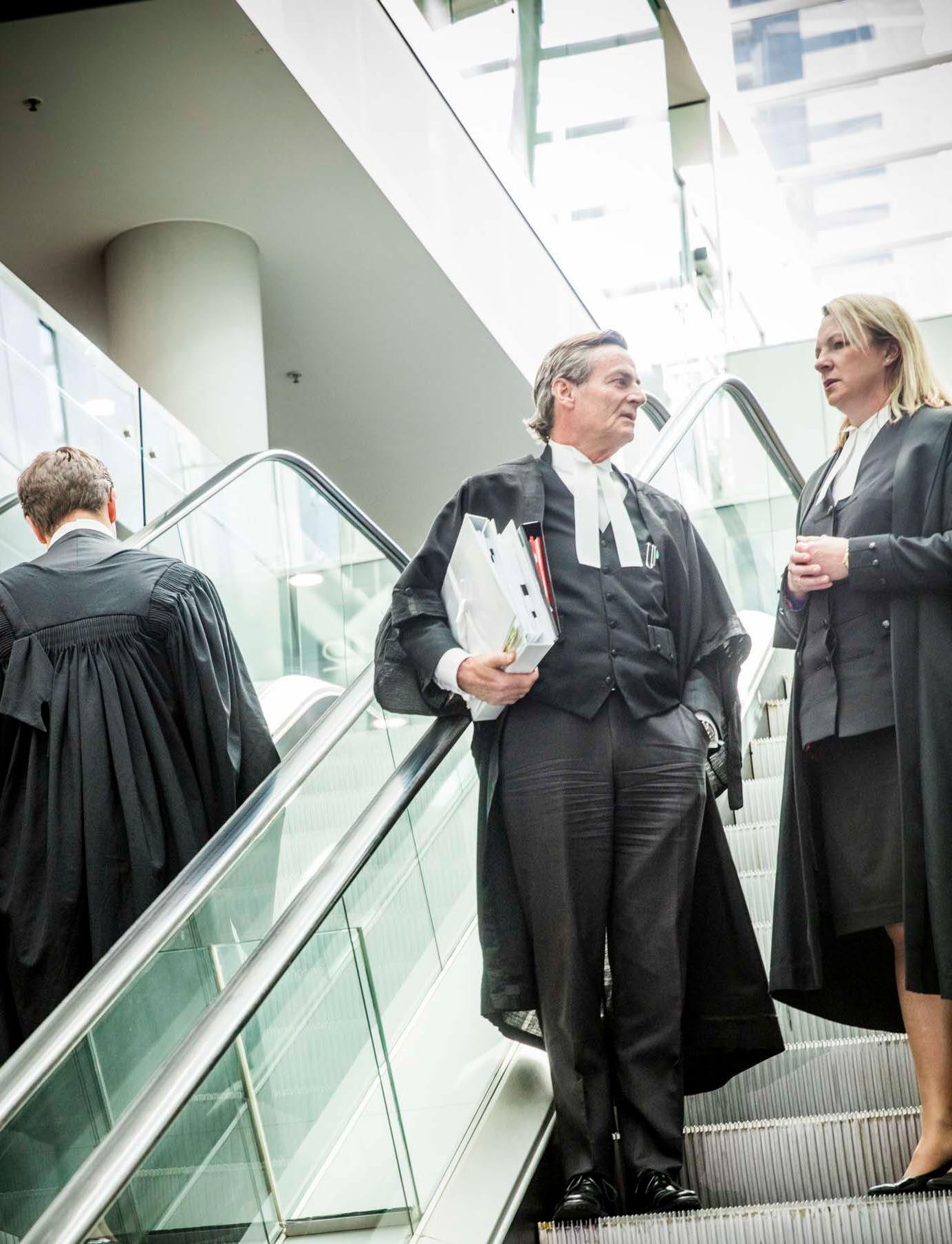
The Bar Council records with deep regret the death of the following members and past members of the Victorian Bar:
2019/20
Stanley Spittle BR No: 863, 17 July 2019
The Honourable David Hunt AO QC BR No: 680, 19 July 2019
Frederick Gordon Tinney BR No: 673, 24 July 2019
The Honourable Kevin Mahony AM BR No: 779, 28 July 2019
Bryan M Dwyer BR No: 2524, 31 July 2019
John Philbrick QC BR No: 1138, 23 August 2019
Joan R Dwyer OAM BR No: 1377, 6 September 2019
Wallace Meehan BR No: 2284, 12 September 2019
Patricia O’Hara BR No: 1214, 3 October 2019
Peter Fox QC BR No: 3076, 6 October 2019
The Hon Richard Tracey AM RFD QC BR No: 1692, 12 October 2019
John Higham OAM BR No: 1254, 20 October 2019
Peter Murley BR Roll No: 793, 29 October 2019
Peter Thomas Fox BR No: 1087, 17 November 2019
Raymond Rosenberg BR No: 1280, 25 November 2020
Robert Todd AM BR No: 583, 9 December 2019
Richard Cook BR No: 1316, 19 December 2019
Stephen J Howells BR No: 2107, 7 January 2020
John Wadsley BR No: 2638, 1 February 2020
Michael Gros BR No: 2025, 17 February 2020
John S Monahan BR No: 666, 20 February 2020
Eugene Trahair BR No: 1891, 22 February 2020
James Westmore BR No: 4684, 26 February 2020
His Honour Fred Davey QC BR No: 681 & 1104, 1 March 2020
Peter O’Callaghan QC BR No: 622, 8 March 2020
His Honour Chester Keon-Cohen AM BR No: 874, 9 March 2020
Robert L Langton BR No: 780, 25 March 2020
Michael Dowling QC BR No: 707, 15 April 2020
The Hon. Barry Beach AM QC BR No: 494, 8 May 2020
Richard J Stanley QC BR No: 795, 7 June 2020
During the year, the following Victorian judges, members and past members of the Victorian Bar were recipients of the following honours:
Australia Day Honours 2020
The Hon Hartley Hansen AM QC
Michael Wright AM QC
David Curtain AM QC
Fiona McLeod AO SC
Dr Suzanne McNicol AM QC
Tom Danos OAM
Dr Sam Ricketson AM
The Queen’s Birthday Honours 2020
The Hon Justice Susan Kenny AM
The Hon Justice Shane Marshall AM
The Hon Robert Redlich AM QC
Martin Bartfeld AM QC
Jennifer Batrouney AM QC
Carolyn Douglas OAM
45 Years at the Bar
John Larkins
David Brustman QC
Thomas Lynch


The following is a statistical profile of membership of the Bar Association and a listing of those joining, leaving or transferring their membership during the year ended 30 June 2020.
The following persons signed, re-signed, transferred or were removed from the Roll of Counsel:
Division A Part I (Victorian Practising Counsel)
Signed
Laurence Fredric White, Georgia McMaster, Dr Mark Burton, Angelo Bartzis, Mihal Miriam Greener, Matthew Charles Gledhill, Morgana Claire Brady, Kathy Karadimas, Jacqueline Anne Hession, Geoffrey James Smith, Nicholas David Mutton, Toni Stokes, Benjamin House, Barbara Marshal Renou, Kay Chan, Karan Raghavan, Tahlia Ferrari, James Bryan Tsien Hwei Eley, Christopher Edward Andrew Hibbard, Paul Annabell, Thomas Bryan Crouch, Charles Thomas Morshead, Ryan Ashley Kornhauser, Martin Philip Radzaj, Joel Tito, Therese Borger, Katherine Elizabeth Wangmann, Holly Jager, Justin Lipinski, Nicole Menegas, Vivienne Margaret Geursen Jones, Rutendo Ruth Muchinguri, Lauren Eleise Burke, Johann Louise Ollquist, Karen Jones Mak, Daye Gang, Timothy Harvey, Sally Luise Buckley, Bethany Joy East, Ryan Hartshorne, Luke Joseph McPhie, Ella Jane Delany, Ganesh Jegatheesan, Sonari Mary Fernando, Kylie Annette Jeans, Eva Weiss, Mitchell David Brogden, David Ian Mence, Joel David Phillips, Stacey Taylor, Stewart Pinkstone, Chrisanthi Paganis, Ned Roche, Jessica Moir, Uthra Ramachandran, Robert Glavas, Erin Rutherford, Lisa Andrews, Adam Craig, Philippa Kelly, Brendan Johnson, Manuel Puyol, Raphael de Vietri, Anna Batrouney, Sanjay Schrapel, John Heard, Elizabeth Warnock, Nicholas Guenther, Nicolas Dour, Michael Keks, Maya Narayan, Alexandra Finemore, Sahrah Hogan, Jenaya Ellis (Rinaldis), Erik Dober, Priya Wakhlu, Andrew McCowan, Nadia Stojanova, Stephanie Brenker, Madeleine Sargent, Peter Botros, Tessa Duthie, James Ryan, Stephanie Gillahan, Anna Dixon, Hazel Whalley, Jeremy Karitzis, Ashleigh Morris, Patrick Tiernan, Matthew Murphy, Samuel Profitt, Andrew Norris, Michael Arbogast, Gregory Lascaris, Timothy Glass, Matthew Weinman, Lachlan Howe
Re-signed
Patricia (Priya) Carey, Robert M Gordon, Cameron James Allen, Ruth E Hamnett, Glen A Pauline, Michelle Zammit, Rachel Waters, Andrew Archer, Philip Cadman
Transfers from Lydia D Ruschena, Timothy J Ryan, Clifford L Pannam QC, Duncan L Allen QC, Steven R Grahame, Mara Ray, Jacob (Jack) I Fajgenbaum QC, Rudi D Cohrssen, Elizabeth A Benjamin, Timothy J Ryan, Richard J Stanley QC, Elliot Perlman, the Honourable Anthony North QC, Arushan Pillay, Holly J E Nash, Michael H Whitten QC, Peter Kozicki, Damien B Maguire, Michael J Colbran QC, Edwina Keynes, Neill F Campbell, Arthur Adams QC, W Clarke Grainger, Piria Coleman, Peter W Murley, Patmalar Ambikapathy, Julian Snow, Benjamin J Mallick, Gerard McKeown, Terence J Casey QC, Michael W Morrison, Barry L James, Lisa M Nichols QC, Anne Hassan SC, David A Glynn, Denis M McDonald, Sitesh Bhojani, C D Neil Griffin, John Billings, Michael J Richards, Justin P Foster, Hayley A Bate, Kristen A Rose, Victoria A Campbell, Andrew D Halse, Helen P Murphy, John Dickie, Allan J D Sharp, Wendy Duncan, Dr Damien Cremean, Matthew C Kowalski, Christopher (Jim) Delany QC, Kathryn L Stynes, David J N Purcell SC, Fiona H Todd, Kenneth G Howden, Don Just, Philip J Kennon QC, Peter G Lovell, Bruce R McTaggart, Ian R Fehring, Gerald A Lewis QC, Keith M Boulton, Chiry Chen, Gerard J Maguire, Ronald K J Meldrum QC, Thomas J Serra, Nic Chow
Transfers to
Margo J Harris, the Honourable Simon Molesworth AO QC, the Honourable Condon QC, Chiry Chen, Brett L Sonnet, John C Billings, Malcolm A Strang, Francesco (Frank) Tallarida, Gavin J C Silbert QC, Steven Castan, Janine V Gleeson, John P Rowland QC, the Honourable Julie Dodds-Streeton QC, Wendy Duncan, Matthew C Kowalski
Removed from
Andrew Archer, Gordon R Ritter QC, Philip H Cadman, Jessica F Swanwick, Joel Harris, Andrew Conley, Andrew Tragardh, Peter S Kilduff, John Armstrong, Jacob Pruden, David Kent-Hughes, Joseph Amin
Division A Part II (Crown Prosecutors & Public Defenders)
Signed
Transfers from Brett L Sonnet, Kevin J Doyle, Frances L Dalziel QC
Transfers to Angela M Moran, David A Glynn, John Dickie
Name removed Brett Young
Division A Part III (Interstate and Overseas Counsel)
Signed David Thomas Cole, Anthony John McInerney, Mark Dempsey SC, William Paul Calokerinos, Dominic Henley Katter
Transfers from Margo J Harris, John P Rowland QC, S Patrick O’Sullivan QC, Steven Castan
Transfers to Edwina Keynes, Rodney Hepburn
Removed from Michael A Fullerton, Lionel Robberds AM QC, Joshua M Hunter, Todd Kovacic, Anthony J L Bannon
Wayne G Muddle SC
Division A Part IV (Victorian Practising Counsel temporarily absent without current PC)
Transfers from
Denis McDonald, Malcolm A Strang, Peter W Murley, James J Isles, Richard St A Kendall QC
Transfers to
Rudi D Cohrssen, Elliot Perlman, Michael J Colbran QC, Peter W Murley, Patmalar Ambikapathy, Julian Snow, Benjamin J Mallick, Chiry Chen, Nic Chow
Removed from Keir Dernelley
Division B (Judiciary and Official Appointments)
Transferred To
His Honour Duncan L Allen QC (appointment as a Reserve Judge of the County Court of Victoria)
The Honourable Anthony North QC (appointment as Chairperson of the Victorian Law Reform Commission)
Arushan Pillay (appointment to the County Court of Victoria)
Holly J E Nash (appointment to the Victorian Civil and Administrative Tribunal)
Michael H Whitten QC (appointment as Lord Chief Justice of the Kingdom of Tonga)
Neill F Campbell (appointment to the Victorian Civil and Administrative Tribunal)
Kim J Knights (appointment to the Victorian Civil and Administrative Tribunal)
Lisa M Nichols QC (appointment to the Supreme Court of Victoria)
Kevin J Doyle (appointment to the County Court of Victoria)
Anne Hassan SC (appointment to the County Court of Victoria)
S Patrick O’Sullivan QC (appointment to the District Court of South Australia)
Sitesh Bhojani (appointment as Commissioner of the Essential Services Commission of Victoria)
John Billings (appointment to the Victorian Civil and Administrative Tribunal)
Frances L Dalziel QC (appointment to the County Court of Victoria)
Michael J Richards (appointment to the Magistrates’ Court of Victoria)
Justin P Foster (appointment to the Magistrates’ Court of Victoria)
Hayley A Bate (appointment to the Magistrates’ Court of Victoria)
Kristen A Rose (appointment to the Magistrates’ Court of Victoria)
Victoria A Campbell (appointment to the Magistrates’ Court of Victoria)
Andrew D Halse (appointment to the Magistrates’ Court of Victoria)
Helen P Murphy (appointment to the Magistrates’ Court of Victoria)
Christopher (Jim) Delany QC (appointment to the Supreme Court of Victoria)
David J N Purcell SC (appointment to the County Court of Victoria)
Fiona H Todd (appointment to the County Court of Victoria)
Kathryn L Stynes (appointment to the Supreme Court of Victoria)
Transfers from
The Honourable Acting Justice Simon Molesworth, her Honour Judge Julie Condon, John C Billings, the Honourable Justice Ruth S McColl AO, the Honourable Anthony M North QC, Janine V Gleeson, the Honourable Justice Julie Dodds-Streeton, Angela M Moran, the Honourable Justice Clyde E Croft AM, the Honourable Justice Kevin H Bell AM, the Honourable Justice Ann Vanstone, the Honourable Justice Michael F Adams, the Honourable Justice Alan Robertson, her Excellency the Honourable Justice
Margaret Beazley AC QC, the Honourable Justice Robert McDougall
Transfers from Chiry Chen, Gavin J C Silbert QC, Francesco (Frank) Tallarida, Wendy Duncan
Transfers to Denis McDonald, Lydia D Ruschena, Timothy J Ryan, Clifford L Pannam QC, Steven R Grahame, Mara Ray, Jacob (Jack) I Fajgenbaum QC, Elizabeth A Benjamin, Timothy J Ryan, Richard Stanley QC, Peter Kozicki, Damien B Maguire, Arthur Adams QC, W Clarke Grainger, Piria Coleman, the Honourable Ruth S McColl AO SC, the Honourable Anthony M North QC, Peter W Murley, Gerard McKeown, James J Isles, Terence J Casey QC, Michael W Morrison, Barry L James, Professor the Honourable Clyde Croft AM SC, Denis M McDonald, C D Neil Griffin, Richard St A Kendall QC, the Honourable Kevin H Bell AM QC, the Honourable Ann Vanstone, Allan J D Sharp, Wendy Duncan, the Honourable Michael Adams QC, Dr Damien Cremean, Kenneth G Howden, Don Just, Philip J Kennon QC, Peter G Lovell, Bruce R McTaggart, Ian R Fehring, Gerald A Lewis QC, Keith M Boulton, Gerard J Maguire, Ronald K J Meldrum QC, Thomas J Serra, Staniforth (Sam) Ricketson AM, the Honourable Alan Robertson, her Excellency the Honourable Margaret Beazley AC QC, the Honourable Robert McDougall
Transfers from Rodney Hepburn, Staniforth (Sam) Ricketson AM
Name Removed Heather King
Patricia (Priya) Carey, Robert M Gordon, Margo J Harris, the Honourable Simon Molesworth AO QC, Laurence Fredric White, the Honourable Julie Condon QC, Chiry Chen, Brett L Sonnet, John C Billings, Cameron James Allen, Dr Mark Burton, Malcolm A Strang, Gavin J C Silbert QC, Angelo Bartzis, Mihal Miriam Greener, Matthew Charles Gledhill, Geoffrey James Smith, Nicholas David Mutton, Toni Stokes, Benjamin House, Barbara Marshal Renou, Paul Eyang Annabell, Kay Chan, Karan Raghavan, Tahlia Ferrari, James Bryan Tsien Hwei Eley, Christopher Edward Andrew Hibbard, Thomas Bryan Crouch, Charles Thomas Morshead, Ryan Ashley Kornhauser, Martin Philip Radzaj, Joel Tito, Therese Borger, Katherine Elizabeth Wangmann, Holly Jager, Justin Lipinski, Nicole Menegas, Vivienne Margaret Geursen Jones, Rutendo Ruth Muchinguri, Lauren Eleise Burke, Johann Louise Ollquist, Karen Jones Mak, Daye Gang, Timothy Harvey, Sally Luise Buckley, Bethany Joy East, Ryan Hartshorne, Luke Joseph McPhie, Ella Jane Delany, Ganesh Jegatheesan, Sonari Mary Fernando, Kylie Annette Jeans, Eva Weiss, Mitchell David Brogden, David Ian Mence, Joel David Phillips, Ruth E Hamnett, Glen A Pauline, John P Rowland QC, Francesco (Frank) Tallarida, the Honourable Julie Dodds-Streeton QC, Steven Castan, Michelle Zammit, Janine V Gleeson, Rachel Waters, Stacey Taylor, Stewart Pinkstone, Chrisanthi Paganis, Ned Roche, Jessica Moir, Uthra Ramachandran, Robert Glavas, Erin Rutherford, Lisa Andrews, Adam Craig, Kelly Philippa, Brendan Johnson, Manuel Puyol, Raphael de Vietri, Anna Batrouney, Sanjay Schrapel, John Heard, Elizabeth Warnock, Nicholas Guenther, Nicolas Dour, Michael Keks, Maya Narayan, Alexandra Finemore, Sahrah Hogan, Jenaya Ellis (Rinaldis), Erik Dober, Priya Wakhlu, Andrew McCowan, Nadia Stojanova, Stephanie Brenker, Madeleine Sargent, Peter Botros, Tessa Duthie, James Ryan, Stephanie Gillahan, Anna Dixon, Hazel Whalley, Jeremy Karitzis, Ashleigh Morris, Patrick Tiernan, Matthew Murphy, Samuel Profitt, Andrew Norris, Michael Arbogast, Gregory Lascaris, Timothy Glass, Matthew Weinman, Lachlan Howe, Philip Cadman
Registered No. A0034304S
Owen Dixon Chambers East
Level 5 / 205 William Street
Melbourne, Victoria 3000
T: 03 9225 7111
F: 03 9225 6068
E: vicbar@vicbar.com.au
W: www.vicbar.com.au
Ms Wendy Harris QC (President)
Mr Simon Marks QC (Senior Vice-President)
Mr Sam Hay SC (Junior Vice-President)
Mr Stewart Maiden QC (Honorary Treasurer)
Mr Paul Holdenson QC
Dr Ian Freckelton QC
Mr Adrian Finanzio SC
Dr Suzanne (Sue) McNicol QC
Ms Helen Rofe QC
Ms Minal Vohra SC
Mr Justin Hannebery QC
Ms Elizabeth Ruddle (now SC)
Ms Meg O’Sullivan
Ms Emily Porter
Ms Gabi Crafti (Assistant Honorary Treasurer)
Ms Sarah Keating
Ms Kathleen Foley
Mr Daniel Nguyen
Ms Raini Zambelli
Ms Reegan Grayson Morison
Ms Rabea Khan
Ms Katherine A Brazenor (Honorary Secretary)
Mr Kieran Hickie (Assistant Honorary Secretary)
Mr Hadi Mazloum (Assistant Honorary Secretary)
ACN 004 454 004
Board of Directors
Mr John Karkar QC (Chairman)
Mr Adrian Finanzio SC (Deputy Chairman)
Ms Penny Neskovcin QC
Ms Susan Brennan SC
Mr Sam Hay SC
Ms Catherine Walter AM
Mr Mick Brennan
Mr Paul Clark (CEO and Managing Director)
ACN 624 652 357
Board of Directors
Ms Susan Brennan SC
Mr Paul Clark
ACN 004 640 108
Ms Wendy Harris QC
Mr Stewart Maiden QC
The officers, members of the Council of the Victorian Bar Incorporated, submit herewith the annual financial report of the Association for the financial year ended 30 June 2020. In order to comply with the provisions of the Associations Incorporation Reform Act 2012 and generally appropriate good practice disclosure, the Officers report as follows: The names of the Officers of the Association during or since the end of the financial year are included on page 13 of the annual report under Bar Council.
The Victorian Bar Incorporated is a professional association for lawyers practising solely as barristers. As well as serving its barrister members, the Bar serves the public interest through its activities in improving access to justice and law reform and its pro bono work. The Bar has two wholly owned subsidiary companies: Barristers Chambers Limited owns and leases buildings, which are provided as chambers to barristers, and provides telephone and internet services to members of the
Bar; and The Melbourne Bar Pty Ltd which is a non-operating nominee company. Barristers Chambers Limited has one wholly owned subsidiary, Opus Workspaces Pty Ltd, which provides serviced office space.
During the financial year ended 30 June 2020 the Association achieved a surplus from ordinary activities of $563,485 (2019: $411,993) after an income tax benefit of $5,669 (2019: $164,528). Its consolidated loss from ordinary activities was $2,321,215 (2018: $32,331,807 profit) after an income tax benefit of $430,177 (2019: $10,347,053 expense).
Except as set out in the accompanying financial reports, there was no significant change in the state of affairs of the Association during the financial year.
The outbreak of COVID-19 and the subsequent quarantine measures imposed, as well as the travel and trade restrictions put in place in early 2020 have caused disruption to businesses and economic activity. In an effort to contain the spread of the virus, the Victorian Government, on 2 August 2020, implemented Stage 4 restrictions in Melbourne and Stage 3 restrictions in regional Victoria with quarantine restrictions, travel restrictions, closure of businesses and other restrictive movement measures.
While restrictions are slowly being eased, the impact of the COVID-19 pandemic is ongoing, and the group will continue to adjust to the varying restrictions. As the situation remains fluid (due to evolving changes in government policy and evolving business and customer reactions thereto) as at the date these financial statements are authorised for issue, the Officers of the Association considered that the financial effects of COVID-19 on the Association’s financial statements cannot be reasonably estimated for future financial periods.
There has been no other matter or circumstance which has arisen since the end of the year that has significantly affected, or may significantly affect the company’s operations, the result of those operations or the company’s state of affairs.
Substantial changes in the operations of the Association are ordinarily determined by a vote of members which are communicated other than through the Annual Report.
The Association is not subject to any significant environmental regulations under Australian law.
The Association is incorporated under the Associations Incorporation Act 1981 (Vic). It is precluded under the Act and its Constitution from paying a dividend to its members. The Association is a not for profit organisation.
During the financial year, the Association paid a premium in respect of a contract insuring the Officers of the Association (as named above and on page 13 of the Annual Report) and all Executive Officers of the Association and of any related body corporate against a liability incurred as an officer or executive officer to the extent permitted by the Association’s Constitution. The contract of insurance prohibits disclosure of the nature of the liability and the amount of the premium.
The Association has not otherwise, during or since the financial year, except to the extent permitted by law, indemnified or agreed to indemnify an officer or auditor of the Association or of any related body corporate against a liability incurred as such an officer or auditor.
Proceedings on Behalf of the Association
No person has applied for leave of court to bring proceedings on behalf of the Association or to intervene in any proceedings to which the Association is a party for the purpose of taking responsibility on behalf of the Association for all or part of those proceedings. Signed in accordance with a resolution of the Council made pursuant to the Constitution of the Victorian Bar.
Associations Incorporation Reform Act 2012
Sections 94(2)(b), 97(2)(b) and 100(2)(b)
Annual Statements Give True and Fair View of Financial Position of Incorporated Association
We, Wendy Harris QC and Stewart Maiden QC, being President and Honorary Treasurer of the Victorian Bar Council respectively, and members of the Victorian Bar Council, which is the Committee of the Victorian Bar Incorporated certify that:
The financial statements (and notes thereto) attached to this certificate give a true and fair view of the financial position of the Victorian Bar Incorporated during and at the end of the financial year of the Association ended on 30 June 2020.
Dated this 16th day of October 2020
On behalf of the Officers

Wendy Harris QC President 16 October 2020

Opinion
We have audited the financial report of The Victorian Bar Incorporated and its subsidiaries (the “Group”), which comprises the consolidated statement of financial position as at 30 June 2020, the consolidated statement of profit or loss and other comprehensive income, consolidated statement of changes in equity and consolidated statement of cash flows for the year then ended, and notes to the financial statements, including a summary of significant accounting policies and declaration by the Officers.
In our opinion the accompanying financial report presents fairly, in all material respects, the Group’s financial position as at 30 June 2020, and of its financial performance and its cash flows for the year then ended in accordance with Australian Accounting Standards to the extent described in Note 3 to the financial report, the Associations Incorporation Reform Act 2012 and the Constitution.
We conducted our audit in accordance with Australian Auditing Standards. Our responsibilities under those standards are further described in the Auditor’s Responsibilities for the Audit of the Financial Report section of our report. We are independent of the Group in accordance with the ethical requirements of the Accounting Professional and Ethical Standards Board’s APES 110 Code of Ethics for Professional Accountants (including Independance Standards) (the Code) that are relevant to our audit of the financial report in Australia. We have also fulfilled our other ethical responsibilities in accordance with the Code.
We believe that the audit evidence we have obtained is sufficient and appropriate to provide a basis for our opinion.
We draw attention to the disclosures made in Note 3 (Critical accounting policies, Critical accounting judgements and key sources of estimation uncertainty) and Note 13 (Investment properties) of the financial report. These notes explain that there is significant estimation uncertainty in relation to the valuation of investment properties of $277,400,000 included
in the consolidated statement of financial position as at 30 June 2020. Our opinion is not modified in respect of this matter.
We draw attention to Note 3 (Critical accounting policies, Statement of compliance), to the financial report, which describes the basis of accounting. The financial report has been prepared for the purpose of fulfilling the Officers financial reporting responsibilities under the Associations Incorporation Reform Act 2012 and the Constitution. As a result, the financial report may not be suitable for another purpose. Our opinion is not modified in respect of this matter.
The Officers are responsible for the other information. The other information comprises the information included in, or distributed with the annual financial report, but does not include the financial report and our auditor’s report thereon. Our opinion on the financial report does not cover the other information and we do not express any form of assurance conclusion thereon.
In connection with our audit of the financial report, our responsibility is to read the other information and, in doing so, consider whether the other information is materially inconsistent with the financial report or our knowledge obtained in the audit or otherwise appears to be materially misstated.
If, based on the work we have performed, we conclude that there is a material misstatement of this other information; we are required to report that fact. We have nothing to report in this regard.
The Officers are responsible for the preparation and fair presentation of the financial report in accordance with Australian Accounting Standards and the Associations Incorporation Reform Act 2012 and the Constitution and for such internal control as the Officers determine is necessary to enable the preparation and fair presentation of the financial report and is free from material misstatement, whether due to fraud or error.
In preparing the financial report, the Officers are responsible for assessing the Group’s ability to continue as a going concern, disclosing, as applicable, matters related to going concern and using the going concern basis of accounting unless the officers either intend to liquidate the Group or to cease operations, or have no realistic alternative but to do so.
Our objectives are to obtain reasonable assurance about whether the financial report as a whole is free from material misstatement, whether due to fraud or error, and to issue an auditor’s report that includes our opinion. Reasonable assurance is a high level of assurance but is not a guarantee that an audit conducted in accordance with the Australian Auditing Standards will always detect a material misstatement when it exists. Misstatements can arise from fraud or error and are considered material if, individually or in the aggregate, they could reasonably be expected to influence the economic decisions of users taken on the basis of this financial report.
As part of an audit in accordance with the Australian Auditing Standards, we exercise professional judgement and maintain professional scepticism throughout the audit. We also:
› Identify and assess the risks of material misstatement of the financial report, whether due to fraud or error, design and perform audit procedures responsive to those risks, and obtain audit evidence that is sufficient and appropriate to provide a basis for our opinion. The risk of not detecting a material misstatement resulting from fraud is higher than for one resulting from error, as fraud may involve collusion, forgery, intentional omissions, misrepresentations, or the override of internal control.
› Obtain an understanding of internal control relevant to the audit in order to design audit procedures that are appropriate in the circumstances, but not for the purpose of expressing an opinion on the effectiveness of the Group’s internal control.
› Evaluate the appropriateness of accounting policies used and the reasonableness of accounting estimates and related disclosures made by the officers.
› Conclude on the appropriateness of the Officers’ use of the going concern basis of accounting and, based on the audit evidence obtained, whether a material uncertainty exists related to events or conditions that may cast significant doubt on the Group’s ability to continue as a going concern. If we conclude that a material uncertainty exists, we are required to draw attention in our auditor’s report to the related disclosures in the financial report or, if such disclosures are inadequate, to modify our opinion. Our conclusions are based on the audit evidence obtained up to the date of our auditor’s report. However, future events or conditions may cause the Group to cease to continue as a going concern.
› Evaluate the overall presentation, structure and content of the financial report, including the disclosures, and whether the financial report represents the underlying transactions and events in a manner that achieves fair presentation.
We communicate with the Officers regarding, among other matters, the planned scope and timing of the audit and significant audit findings, including any significant deficiencies in internal control that we identify during our audit.


Robert Collie Partner
Chartered Accountants
Melbourne, 15 October 2020
The Officers have determined that the Victorian Bar Inc (the “Association”) is not a reporting entity because in the opinion of the Officers there are unlikely to exist users of the financial report who are unable to command the preparation of reports tailored so as to satisfy specifically all of their information needs. Accordingly, this special purpose financial report has been prepared to satisfy the Officer’s reporting requirements under the Victorian Bar Inc.’s Constitution and the Associations Incorporation Reform Act 2012.
The Officers of the Association declare that:
1. The financial statements and notes thereto, as set out on pages 60 to 82:
a. Comply with accounting standards, the Associations Incorporation Reform Act 2012 and the reporting requirements under the Victorian Bar’s Constitution; and
b. Give a true and fair view of the financial position as at 30 June 2020 and performance for the year ended on that date, in accordance with the accounting policies described in Note 3 to the financial statements, of the Association and the Group entities.
2. In the Officers opinion there are reasonable grounds to believe that the Association will be able to pay its debts as and when they become due and payable.
Signed in accordance with a resolution of the Council of the Association.
On behalf of the Officers

Wendy Harris QC President
Melbourne, 16 October 2020
Stewart Maiden QC Honorary Treasurer
Melbourne, 16 October 2020
Statement of profit or loss and other comprehensive income for the year ended 30 June 2020
Statement of financial position at 30 June 2020
(7,630,469) -
Technology expenses (1,998,228) (1,470,622) -
Utilities expense (3,132,917) (2,836,011) -
(Loss)/profit before income tax expense
of cash flows for the year ended 30 June 2020
The accompanying notes form part of these financial statements.
The accompanying notes form part of these financial statements.
The Victorian Bar Inc. (“the Association”) is incorporated under the Associations Incorporation Reform Act 2012, Victoria and operates in Australia.
The registered office and the principal place of business of the Association is:
Level 5, 205 William Street Melbourne VIC 3000
The Association is a private, voluntary, self-funded, non-profit, professional association of barristers who practise in Victoria. Its principal activity during the year was to provide regulatory and other services to barristers who practice in Victoria.
2.1 Amendments to Accounting Standards that are mandatorily effective for the current reporting period
The Association has adopted all the new and revised Standards and Interpretations issued by the Australian Accounting Standards Board (the AASB) that are relevant to their operations and effective for an accounting period that begins on or after 1 July 2019. These include:
• AASB 1058 Income of Not-for-Profit Entities and AASB 15 Revenue from Contracts with Customers and • AASB 16 Leases
AASB 1058 Income of Not-for-Profit Entities and AASB 15 Revenue from Contracts with Customers In the current year, the Group has applied AASB 1058 Income of Not-for-Profit Entities and AASB 15 Revenue from Contracts with Customers which are effective for an annual period that begin on or after 1 January 2019.
The Group has applied AASB 1058 and AASB 15 in accordance with the modified retrospective (cumulative catch up) method where the comparative figures are not restated. Instead, the Association has recognised the cumulative effect of initially applying AASB 1058 and AASB 15 for the first time for the year ending 30 June 2020 against retained earnings as at 1 July 2019. The Association has also elected to apply AASB 1058 and AASB 15 retrospectively only to contracts and transactions that are not ‘completed contracts’ as at 1 July 2019.
AASB 1058 clarifies and simplifies the income recognition requirements that apply to not-for-profit (NFP) entities, in conjunction with AASB 15. The new income recognition requirements shift the focus from a reciprocal/non-reciprocal basis to a basis of assessment that considers the enforceability of a contract and the specificity of performance obligations.
The core principle of the new income recognition requirements in AASB 1058 is when a NFP entity enters into transactions where the consideration to acquire an asset is significantly less than the fair value of the asset principally to enable the entity to further its objectives, the excess of the asset recognised (at fair value) over any ‘related amounts’ is recognised as income immediately.
An example of a ‘related amount’ is AASB 15 and in cases where there is an ‘enforceable’ contact with a customer with ‘sufficiently specific’ performance obligations, income is recognised when (or as) the performance obligations are satisfied under AASB 15, as opposed to immediate income recognition under AASB 1058.
AASB 15 introduces a 5-step approach to revenue recognition, which is more prescriptive than AASB 118.
Under AASB 15, a company recognises revenue when (or as) a performance obligation is satisfied, i.e. when “control” of the goods or services underlying the particular performance obligation is transferred to the customer.
The Association recognises revenue from the following major sources:
- Subscriptions;
- Technology revenue;
- Readers course, mediation & seminar fees;
- Managed floor solutions and;
- Rental income.
In the current year, the Association has applied AASB 16 Leases
The standard replaces the existing guidance on leases, including AASB 117 Leases. AASB 16 introduces significant changes to lessee accounting by removing the distinction between operating and finance leases and requiring the recognition of a right-of-use asset and a lease liability at the lease commencement for all leases, except for short-term leases and leases of low value assets.
The Association has applied AASB 16 for the time as of 1 July 2019, using the modified retrospective approach. During the first-time application of AASB 16 under the modified retrospective approach (Option B), the right-of-use asset is measured as if AASB 16 had been applied from lease commencement but using the incremental borrowing rate at the date of transition. In applying the modified retrospective approach, there has been no restatement of comparatives.
2.1 Amendments to Accounting Standards that are mandatorily effective for the current reporting period (continued)
The date of initial application of AASB 16 for the Association is 1 July 2019.
The Association has applied AASB 16 using the modified retrospective approach and therefore the comparative information has not been restated.
(a) Impact of the new definition of a lease
The Association has made use of the practical expedient available on transition to AASB 16 not to reassess whether a contract is or contains a lease. Accordingly, the definition of a lease in accordance with AASB 117 and Interpretation 4 will continue to be applied to those contracts entered or modified before 1 January 2019.
The change in definition of a lease mainly relates to the concept of control. AASB 16 determines whether a contract contains a lease on the basis of whether the customer has the right to control the use of an identified asset for a period of time in exchange for consideration. This contrasts with the focus on ‘risks and rewards’ in AASB 117 and Interpretation 4.
The Association applies the definition of a lease and related guidance set out in AASB 16 to all contracts entered into or changed on or after 1 January 2019. In preparation for the firsttime application of AASB 16, the Association has carried out an implementation project. The project has shown that the new definition in AASB 16 will not significantly change the scope of contracts that meet the definition of a lease for the Association.
(b) Impact on Lessee Accounting (i) Former operating leases
AASB 16 changes how the Association accounts for leases previously classified as operating leases under AASB 117, which were off balance sheet.
Applying AASB 16, for all leases (except as noted below), the Association:
(a) recognises right-of-use assets and lease liabilities in the consolidated statement of financial position, initially measured at the present value of the future lease payments;
(b) recognises depreciation of right-of-use assets and interest on lease liabilities in profit or loss; and
(c) separates the total amount of cash paid into a principal portion (presented within financing activities) and interest (presented within operating activities) in the consolidated statement of cash flows.
Lease incentives (e.g. rent-free period) are recognised as part of the measurement of the right-of-use assets and lease liabilities whereas under AASB 117 they resulted in the recognition of a lease incentive, amortised as a reduction of rental expenses generally on a straight-line basis.
Under AASB 16, right-of-use assets are tested for impairment in accordance with AASB 136.
For short-term leases (lease term of 12 months or less) and leases of low-value assets (such as tablet and personal computers, small items of office furniture and telephones), the Association has opted to recognise a lease expense on a straight-line basis as permitted by AASB 16. This expense is presented within ‘other expenses’ in profit or loss.
2.1 Amendments to Accounting Standards that are mandatorily effective for the current reporting period (continued)
AASB 16 Leases and related amending standards (cont’d)
The effect on 1 July 2019 of the recognition of the new right-of-use assets and lease liabilities is disclosed below: 1 July 2019
Increase in right-of-use assets
in
Increase in lease liabilities –
Impact on retained earnings
The effect on the financial performance of the Group for the year ended 30 June 2020 in relation to the adoption of AASB 16 is disclosed below: 30 June
The below outlines the reconciliation of operating lease commitments at the end of the financial reporting year ended 30 July 2020 to the lease liability recognised in the consolidated statement of financial position after initial application of AASB 16.
The Association as lessor
The Association enters into lease agreements as a lessor with respect to some of its investment properties. The Association also rents equipment. Leases for which the Association is a lessor are classified as finance or operating leases.
Whenever the terms of the lease transfer substantially all the risks and rewards of ownership to the lessee, the contract is classified as a finance lease. All other leases are classified as operating leases.
When the Association is an intermediate lessor, it accounts for the head lease and the sub-lease as two separate contracts. The sublease is classified as a finance or operating lease by reference to the right-of-use asset arising from the head lease.
Rental income from operating leases is recognised on a straight-line basis over the term of the relevant lease. Initial direct costs incurred in negotiating and arranging an operating lease are added to the carrying amount of the leased asset and recognised on a straight-line basis over the lease term. Amounts due from lessees under finance leases are recognised as receivables at the amount of the Association’s net investment in the leases. Finance lease income is allocated to accounting periods so as to reflect a constant periodic rate of return on the Association’s net investment outstanding in respect of the leases.
When a contract includes lease and non-lease components, the Association applies AASB 15 Revenue from Contracts from Customers to allocate the consideration under the contract to each component.
Hire Income
Hire income comprises of revenue earned from the provision of the hire equipment, products and/or services relating to the hire. Hire income from operating leases is recognised on a straight-line basis over the term of the relevant lease. Initial direct costs incurred in negotiating and arranging an operating lease are added to the carrying amount of the leased asset and recognised on a straight-line basis over the lease term.
2.2 New and revised Australian Accounting Standards in issue but not yet effective
At the date of authorisation of the financial statements, the Group has not applied the following new and revised Australian Accounting Standards, Interpretations and amendments that have been issued but are not yet effective:
Standards/amendment
AASB 2018-6 Amendments to Australian Accounting Standards
– Definition of a Business
AASB 2018-7 ‘Amendments to Australian Accounting Standards
– Definition of Material’
AASB 2019-1 Amendments to Australian Accounting Standards
– References to the Conceptual Framework
AASB 2019-3 ‘Amendments to Australian Accounting Standards
– Interest Rate Benchmark Reform’
AASB 2019-5 ‘Amendments to Australian Accounting Standards
– Disclosure of the Effect of New IFRS Standards Not Yet Issued in Australia’
AASB 2020-1 Amendments to Australian Accounting Standards
– Classification of Liabilities as Current or Non-Current
AASB 2020-3 Amendments to Australian Accounting Standards
– Annual Improvements 2018-2020 and Other Amendments
AASB 2020-4 Amendments to Australian Accounting Standards
– Covid-19-Related Rent Concessions
The potential impact of the revised Standards/Interpretations on the Association’s financial statements has not yet been determined.
The Officers have determined that the Association is not a reporting entity because, in the opinion of the Officers, there are unlikely to exist users of the financial report who are unable to command the preparation of reports tailored to satisfy specifically all of their information needs. Accordingly, this special purpose financial report has been prepared to satisfy the Officer’s reporting requirements under The Victorian Bar Inc.’s Constitution and the Associations Incorporation Reform Act 2012
For the purpose of preparing the financial statement, the Association is a not for profit entity.
Statement of compliance
The financial report has been prepared in accordance with the Associations Incorporation Reform Act 2012, the Victorian Bar Inc. Constitution, the basis of accounting specified by all Accounting Standards and Interpretations, and the disclosure requirements of Accounting Standards AASB 101 ‘Presentation of Financial Statements’, AASB 107 ‘Statements of Cash Flow’, AASB 108 ‘Accounting Policies’, ‘Changes in Accounting Estimates and Errors’, and ‘AASB 1054 Australian Additional Disclosures’.
The financial report includes the separate financial statements of the Association and the consolidated financial statements of the Group.
Basis of preparation
The financial report has been prepared on the basis of historical cost, except for the revaluation of certain non-current assets and financial instruments. Cost is based on the fair values of the consideration given in exchange for assets. All amounts are presented in Australian dollars, unless otherwise noted.
In the application of the Group’s accounting policies, management is required to make judgments, estimates and assumptions about carrying values of assets and liabilities that are not readily apparent from other sources. The estimates and associated assumptions are based on historical experience and various other factors that are considered relevant. Actual results may differ from these estimates.
The estimates and underlying assumptions are reviewed on an ongoing basis. Revisions to accounting estimates are recognised in the period in which the estimate is revised if the revision affects only that period or in the period of the revision and future periods if the revision affects both current and future periods.
The Group obtains independent valuations for its investment properties on at least a biennial basis or when there is a significant change in market conditions. All three properties owned by the Group were independently valued at 30 June 2020. The fair values of properties are calculated using a combination of market sales comparison and capitalisation rate. The fair value measurement of investment property has been classified as a level 3 fair value as it’s derived from valuation techniques that include inputs that are not based on observable market data (unobservable inputs).The key judgements for each unobservable valuation input are:
• market sales comparison: utilises recent sales of comparable properties, adjusted for any differences including the nature, location and lease profile. The market rent applied at 30 June 2020 across the three properties ranged from $490 to $666psm;
• capitalisation rate: capitalises the fully-leased net income for a property into perpetuity at an appropriate capitalisation rate.
The fully leased net income is based on market rents, operating costs and future income on vacant space. The capitalisation rate reflects the nature, location and tenancy profile, together with current market evidence and sales, of comparable properties. The capitalisation rates applied at 30 June 2020 across the three properties ranged from 4.50% -5.75%.
• Discount rate: reflects the time value of money and risk profile of each property in the calculation of its fair value. The discount rate applied at 30 June 2020 across the three properties ranged from 4.25% - 5.50%. The fair value of the properties is sensitive to these assumptions, in particular the market capitalisation rate. If the market capitalisation rate applied in the valuations was adjusted +/-25 basis points, the fair value would be $15,842k higher or $14,372k lower than the amount recognised at 30 June 2020.
Given the unknown future impact COVID-19 might have on the commercial real estate market, coupled with a lower interest rate environment, a higher degree of judgement is required in assessing the inputs that determine property valuations. Management and independent specialist valuers acknowledge current valuations are subject to “significant valuation uncertainty” as a consequence of this. A reduction in transaction volumes has made direct comparison as a method more difficult. To date, there has been little evidence to suggest
that capitalisation and discount rates have softened since the onset of COVID-19. As COVID-19 has progressed, the Group has continued to reassess the valuations to ensure they remain appropriate and that no other market information has become available to indicate a material change to the assumptions applied. However, the fair values are a best estimate and may differ to the actual sales price if the properties were to be sold.
The Group has assessed the impact of COVID-19 on the expected credit loss allowance against trade receivables outstanding at 30 June 2020. Current and expected collection of trade receivables since the start of the COVID-19 pandemic has been reflected in the assessment. The Group’s expected credit loss allowance increased from $177k at 30 June 2019 to $1,228k as at 30 June 2020. The ongoing COVID-19 related restrictions in Victoria means that collection of outstanding receivables is inherently uncertain and actual collections may differ from the amount included in the expected credit loss allowance at 30 June 2020.
The Group has various “make good” obligations under its long-term property lease contracts. A provision has been recognised for the present value of the estimated expenditure required to fulfil these obligations at the end of the lease terms. The estimated costs are based on recent make good activity performed by the Group and quotes from suppliers. The range applied to each property is between $444 and $290 per square metre and varies based on the extent of the works required and the standard of the building. Since the works on the various properties will be performed well into the future and can be subject to negotiated outcomes with landlords, the actual cost to make good the properties could differ from the provision recognised as at 30 June 2020.
The consolidated financial statements incorporate the financial statements of the Association and entities controlled by the Association (its subsidiaries) made up to 30 June each year. Control is achieved when the Association:
• has the power over the investee;
• is exposed, or has rights, to variable returns from its involvement with the investee; and has the ability to use its power to affects its returns.
The Association reassesses whether it controls an investee if facts and circumstances indicate that there are changes to one or more of the three elements of control listed above.
Consolidation of a subsidiary begins when the Association obtains control over the subsidiary and ceases when the Association loses control of the subsidiary. Specifically, the results of subsidiaries acquired or disposed of during the year are included in profit or loss from the date the Association gains control until the date when the Association ceases to control the subsidiary.
(a) Principles of consolidation (continued)
Where necessary, adjustments are made to the financial statements of subsidiaries to bring the accounting policies used into line with the Group’s accounting policies.
All intragroup assets and liabilities, equity, income, expenses and cash flows relating to transactions between the members of the Group are eliminated on consolidation.
Cash comprises cash on hand and on demand deposits. Cash equivalents are short-term, liquid investments that are readily convertible to known amounts of cash and which are subject to an insignificant risk of changes in value. Bank overdrafts are shown within borrowings in current liabilities in the statement of financial position.
A liability is recognised for benefits accruing to employees in respect of wages and salaries, annual leave and long service leave when it is probable that settlement will be required, and they are capable of being measured reliably.
Liabilities recognised in respect of employee benefits expected to be settled within 12 months are measured at their nominal values using the remuneration rate expected to apply at the time of settlement.
Liabilities recognised in respect of employee benefits which are not expected to be settled within 12 months are measured as the present value of the estimated future cash outflows to be made by the Group in respect of services provided by employees up to the reporting date.
Subscription income received by the Association from its members is non-taxable through the mutuality principle. Receipts from non-members are regarded as assessable income for income tax purposes. Member expenses are non-deductible. Other expenses which are not directly deductible from assessable income are apportioned between non-tax deductible and tax-deductible expenses according to taxation regulations.
All income received by Barristers Chambers Limited, a subsidiary association of the Association, and its subsidiary (Opus Workspaces Pty Ltd), is taxable.
The charge for current income tax expenses is based on the profit for the year adjusted for any non-assessable or disallowed items. It is calculated using tax rates that have been enacted or are substantively enacted by the balance sheet date.
Deferred tax is accounted for using the balance sheet liability method in respect of temporary differences arising between the tax bases of assets and liabilities and their carrying amounts in the financial statements. No deferred income tax will be recognised from the initial recognition of an asset or liability, excluding a business combination, where there is no effect on accounting or taxable profit or loss.
Deferred tax is calculated at the tax rates that are expected to apply to the period when the asset is realised, or liability is settled. Deferred tax is credited in the income statement except where it relates to items credited or debited directly to equity, in which case the deferred tax is adjusted directly against equity.
Deferred income tax assets are recognised to the extent that it is probable that future tax profits will be available against which deductible temporary differences or unused tax losses and tax offsets can be utilised.
The amount of benefits brought to account or which may be realised in the future is based on the assumption that no adverse change will occur in income taxation legislation and the anticipation that the economic entity will derive sufficient future assessable income to enable the benefit to be realised and comply with the conditions of deductibility imposed by the law.
The Association and its subsidiaries, Barristers’ Chambers Ltd and The Melbourne Bar Pty Ltd, together with Opus Workspaces Pty Ltd, are part of a tax-consolidated Group under Australian taxation law. The Association is the head entity in the tax-consolidated Group. Tax expense/income, deferred tax assets and deferred tax liabilities arising from temporary differences of the members of the tax-consolidated Group are recognised using the ‘Group allocation’ approach by reference to the carrying amounts in the separate financial statements of each entity and the tax values applying under tax consolidation. Current tax liabilities and assets and deferred tax assets arising from unused tax losses and relevant tax credits of the members of the tax-consolidated Group are recognised by the Association (as head entity in the tax-consolidation Group).
(f)
Plant and equipment, leasehold improvements and equipment under finance lease are stated at cost less accumulated depreciation and impairment. Cost includes expenditure that is directly attributable to the acquisition of the item. In the event that settlement of all or part of the purchase consideration is deferred, cost is determined by discounting the amounts payable in the future to their present value as at the date of acquisition.
The carrying amount of plant and equipment is reviewed annually by the Association’s Officers to ensure it is not in excess of the recoverable amount from these assets. The recoverable amount is assessed on the basis of the expected net cash.
(f)
plant and equipment (continued)
The depreciable amount of all property, plant and equipment including buildings and capitalised leased assets, but excluding freehold land, is depreciated on a straight-line basis over their useful lives to the economic entity commencing from the time the asset is held ready for use. Leasehold improvements are depreciated over the shorter of either the unexpired period of the lease or the estimated useful lives of the improvements.
The assets’ residual values and useful lives are reviewed, and adjusted if appropriate, at each reporting period. An asset’s carrying amount is written down immediately to its recoverable amount if the asset’s carrying amount is greater than its estimated recoverable amount. Gains and losses on disposals are determined by comparing proceeds with the carrying amount.
These gains and losses are included in the income statement. When revalued assets are sold, amounts included in the revaluation reserve relating to that asset are transferred to retained earnings.
Investment properties, land and office buildings, are held for rental yields and are not occupied by the Group. They are carried at fair value. Changes in fair values are presented in profit and loss as part of other income. The cost of major renovations and improvements are capitalised as an addition. The cost of maintenance, repairs and minor improvements are charged to profit and loss when incurred.
The Group obtains independent valuations for its investment properties at least every two years. At the end of each reporting period, the Officers update their assessment of the fair value of each property, taking into account the most recent independent valuations. The Group determine a property’s value within a range of reasonable fair value estimates.
The best evidence of fair value is current prices in an active market for similar properties. Where such information is not available the officers consider information from a variety of sources including:
• current prices in an active market for properties of different nature or recent prices of similar properties in less active markets, adjusted to reflect those differences;
• discounted cash flow projections based on reliable estimates of future cash flows; and
• capitalised income projections based upon a property’s estimated net market income, and a capitalisation rate derived from an analysis of market evidence.
Intangible assets with finite lives that are acquired separately are carried at cost less accumulated amortisation and accumulated impairment losses. Amortisation is recognised on a straight-line basis over their estimated useful lives. The estimated useful life and amortisation method are reviewed at the end of each reporting period, with the effect of any changes in estimate being accounted for on a prospective basis. Intangible assets with indefinite useful lives that are acquired separately are carried at cost less accumulated impairment losses.
An internally generated intangible asset arising from development (or from the development phase of an internal project) is recognised if, and only if, all of the following have been demonstrated: the technical feasibility of completing the intangible asset so that it will be available for use or sale; the intention to complete the intangible asset and use or sell it; the ability to use or sell the intangible asset; how the intangible asset will generate probable future economic benefits; the availability of adequate technical, financial and other resources to complete the development and to use or sell the intangible asset; and the ability to measure reliably the expenditure attributable to the intangible asset during its development.
The amount initially recognised for internally generated intangible assets is the sum of the expenditure incurred from the date when the intangible asset first meets the recognition criteria listed above. Where no internally generated intangible asset can be recognised, development expenditure is recognised in profit or loss in the period in which it is incurred.
Subsequent to initial recognition, internally generated intangible assets are reported at cost less accumulated amortisation and accumulated impairment losses, on the same basis as intangible assets that are acquired separately.
Provisions are recognised when the Group has a present obligation (legal or constructive) as a result of a past event, it is probable that the Group will be required to settle the obligation, and a reliable estimate can be made of the amount of the obligation.
The amount recognised as a provision is the best estimate of the consideration required to settle the present obligation at reporting date, taking into account the risks and uncertainties surrounding the obligation. Where a provision is measured using the cashflows estimated to settle the present obligation, its carrying amount is the present value of those cashflows.
3. Significant accounting policies (continued)
(i) Provisions (continued)
When some or all of the economic benefits required to settle a provision are expected to be recovered from a third party, the receivable is recognised as an asset if it is virtually certain that reimbursement will be received and the amount of the receivable can be measured reliably.
The Group is required to restore leased premises to their original condition at the end of the respective lease terms. A provision is recognised for the present value of the estimated expenditure required to remove any leasehold improvements where the obligation and the amount can be reliably estimated.
Trade payables and other accounts payable are recognised when the Group becomes obliged to make future payments resulting from the purchase of goods and services.
Revenue from subscriptions is recognised in the period that the subscription relates to. Revenue from leased properties is recognised on a straight-line basis over the lease term in accordance with lease agreements.
Revenue from the rendering of a service is recognised upon the delivery of the service to the customer by reference to the stage of completion of the service being provided.
Revenue from leased properties is recognised as invoiced on a monthly basis based on the short term tenancy agreements with barristers.
Interest revenue is accrued on a time basis, by reference to the principal outstanding and at the effective interest rate applicable, which is the rate that exactly discounts estimated future cash receipts through the expected life of the financial asset to that asset’s net carrying amount.
All other revenue is stated net of the amount of goods and services tax (GST).
Borrowings are recorded initially at fair value, net of transaction costs. Subsequent to initial recognition, borrowings are measured at amortised cost with any difference between the initial recognised amount and the redemption value being recognised in profit and loss over the period of the borrowing using the effective interest rate method.
Bills of exchange are recorded at an amount equal to the net proceeds received, with the premium or discount amortised
over the period until maturity. Interest expense is recognised on an effective yield basis.
Borrowing costs directly attributable to the acquisition, construction or production of assets that necessarily take a substantial period of time to prepare for their intended use or sale, are added to the cost of those assets, until such time as the assets are substantially ready for their intended use or sale.
All other borrowing costs are recognised in the income statement in the period in which they are incurred.
Revenues, expenses and assets are recognised net of the amount of goods and services tax (GST), except:
i. where the amount of GST incurred is not recoverable from the taxation authority, it is recognised as part of the cost of acquisition of an asset or as part of an item of expense; or ii. for receivables and payables which are recognised inclusive of GST.
The net amount of GST recoverable from, or payable to, the taxation authority is included as part of receivables or payables. Cash flows are included in the cash flow statement on a net basis. The GST component of cash flows arising from investing and financing activities which is recoverable from, or payable to, the taxation authority is classified as operating cash flows.
At each reporting date, the Association reviews the carrying amounts of its tangible and intangible assets to determine whether there is any indication that those assets have suffered an impairment loss. If any such indication exists, the recoverable amount of the asset is estimated in order to determine the extent of the impairment loss (if any). Where the asset does not generate cash flows that are independent from other assets, the Association estimates the recoverable amount of the cash-generating unit to which the asset belongs. Where a reasonable and consistent basis of allocation can be identified, corporate assets are also allocated to individual cash-generating units, or otherwise they are allocated to the smallest Group of cash-generating units for which a reasonable and consistent allocation basis can be identified.
Recoverable amount is the higher of fair value less costs to sell and value in use. In assessing value in use, the estimated future cash flows are discounted to their present value using a pre-tax discount rate that reflects current market assessments of the time value of money and the risks specific to the asset for which the estimates of future cash flows have not been adjusted.
If the recoverable amount of an asset (or cash-generating unit) is estimated to be less than its carrying amount, the carrying amount of the asset (cash-generating unit) is reduced to its recoverable
(n) Impairment of tangible and intangible assets other than goodwill (continued)
amount. An impairment loss is recognised immediately in profit or loss, unless the relevant asset is carried at revalued amount, in which case the impairment loss is treated as a revaluation decrease.
Where an impairment loss subsequently reverses, the carrying amount of the asset (cash-generating unit) is increased to the revised estimate of its recoverable amount, but only to the extent that the increased carrying amount does not exceed the carrying amount that would have been determined had no impairment loss been recognised for the asset (cashgenerating unit) in prior years. A reversal of an impairment loss is recognised immediately in profit or loss, unless the relevant asset is carried at fair value, in which case the reversal of the impairment loss is treated as a revaluation increase.
Financial assets and financial liabilities are recognised when the Group becomes a party to the contractual provisions of the instrument.
Financial assets and financial liabilities are initially measured at fair value. Transaction costs that are directly attributable to the acquisition or issue of financial assets and financial liabilities (other than financial assets and financial liabilities at fair value through profit or loss) are added to or deducted from the fair value of the financial assets or financial liabilities, as appropriate, on initial recognition. Transaction costs directly attributable to the acquisition of financial assets or financial liabilities at fair value through profit or loss are recognised immediately in profit or loss.
All regular way purchases or sales of financial assets are recognised and derecognised on a trade date basis. Regular way purchases or sales are purchases or sales of financial assets that require delivery of assets within the time frame established by regulation or convention in the marketplace.
All recognised financial assets are measured subsequently in their entirety at either amortised cost or fair value, depending on the classification of the financial asset.
Financial assets that meet the following conditions are measured subsequently at amortised cost:
• the financial asset is held within a business model whose objective is to hold financial assets in order to collect contractual cash flows; and
• the contractual terms of the financial asset give rise on specified dates to cash flows that are solely payments of principal and interest on the principal amount outstanding.
By default, all other financial assets are measured subsequently at fair value through profit or loss (FVTPL).
The Association’s financial assets at amortised cost includes trade receivables.
Amortised cost and effective interest method
The amortised cost of a financial asset is the amount at which the financial asset is measured at initial recognition minus the principal repayments, plus the cumulative amortisation using the effective interest method of any difference between that initial amount and the maturity amount, adjusted for any loss allowance. The gross carrying amount of a financial asset is the amortised cost of a financial asset before adjusting for any loss allowance.
The effective interest method is a method of calculating the amortised cost of a debt instrument and of allocating interest income over the relevant period.
For financial assets other than purchased or originated credit-impaired financial assets (i.e. assets that are credit-impaired on initial recognition), the effective interest rate is the rate that exactly discounts estimated future cash receipts (including all fees and points paid or received that form an integral part of the effective interest rate, transaction costs and other premiums or discounts) excluding expected credit losses, through the expected life of the debt instrument, or, where appropriate, a shorter period, to the gross carrying amount of the debt instrument on initial recognition. For purchased or originated credit-impaired financial assets, a credit-adjusted effective interest rate is calculated by discounting the estimated future cash flows, including expected credit losses, to the amortised cost of the debt instrument on initial recognition.
The Association recognises a loss allowance for expected credit losses on trade receivables. The amount of expected credit losses is updated at each reporting date to reflect changes in credit risk since initial recognition of the respective financial instrument.
The Association always recognises lifetime expected credit losses (ECL) for trade receivables. The expected credit losses on these financial assets are estimated using a provision matrix based on the association’s historical credit loss experience, adjusted for factors that are specific to the debtors, general economic conditions and an assessment of both the current as well as the forecast direction of conditions at the reporting date, including time value of money where appropriate.
Lifetime ECL represents the expected credit losses that will result from all possible default events over the expected life of a financial instrument.
During 2020, a provision on expected credit losses has been recorded.
3. Significant accounting policies (continued)
(o) Financial instruments (continued)
and recognition of expected credit losses
The measurement of expected credit losses is a function of the probability of default, loss given default (i.e. the magnitude of the loss if there is a default) and the exposure at default. The assessment of the probability of default and loss given default is based on historical data adjusted by forward-looking information as described above. As for the exposure at default, for financial assets, this is represented by the assets’ gross carrying amount at the reporting date; for financial guarantee contracts, the exposure includes the amount drawn down as at the reporting date, together with any additional amounts expected to be drawn down in the future by default date determined based on historical trend, the entity’s understanding of the specific future financing needs of the debtors, and other relevant forward-looking information.
For financial assets, the expected credit loss is estimated as the difference between all contractual cash flows that are due to the association in accordance with the contract and all the cash flows that the association expects to receive, discounted at the original effective interest rate.
If the Group has measured the loss allowance for a financial instrument at an amount equal to lifetime ECL in the previous reporting period, but determines at the current reporting date that the conditions for lifetime ECL are no longer met, the Group measures the loss allowance at an amount equal to 12-month ECL at the current reporting date, except for assets for which simplified approach was used.
The Association recognises an impairment gain or loss in profit or loss for all financial instruments with a corresponding adjustment to their carrying amount through a loss allowance account.
The Group derecognises a financial asset only when the contractual rights to the cash flows from the asset expire, or when it transfers the financial asset and substantially all the risks and rewards of ownership of the asset to another entity. If the entity neither transfers nor retains substantially all the risks and rewards of ownership and continues to control the transferred asset, the entity recognises its retained interest in the asset and an associated liability for amounts it may have to pay. If the entity retains substantially all the risks and rewards of ownership of a transferred financial asset, the entity continues to recognise the financial asset and also recognises a collateralised borrowing for the proceeds received.
On derecognition of a financial asset measured at amortised cost, the difference between the asset’s carrying amount
and the sum of the consideration received and receivable is recognised in profit or loss.
The fair value change on qualifying hedging instruments is recognised in profit or loss except when the hedging instrument hedges an equity instrument designated at fair value through other comprehensive income (“FVTOCI”) in which case it is recognised in other comprehensive income.
The carrying amount of a hedged item not already measured at fair value is adjusted for the fair value change attributable to the hedged risk with a corresponding entry in profit or loss. For debt instruments measured at FVTOCI, the carrying amount is not adjusted as it is already at fair value, but the hedging gain or loss is recognised in profit or loss instead of other comprehensive income. When the hedged item is an equity instrument designated at FVTOCI, the hedging gain or loss remains in other comprehensive income to match that of the hedging instrument.
Where hedging gains or losses are recognised in profit or loss, they are recognised in the same line as the hedged item.
The Group discontinues hedge accounting only when the hedging relationship (or a part thereof) ceases to meet the qualifying criteria (after rebalancing, if applicable). This includes instances when the hedging instrument expires or is sold, terminated or exercised. The discontinuation is accounted for prospectively. The fair value adjustment to the carrying amount of the hedged item arising from the hedged risk is amortised to profit or loss from that date.
Financial liabilities, including borrowings and trade and other payables, are initially measured at fair value, net of transaction costs.
All financial liabilities are measured subsequently at amortised cost using the effective interest method.
After initial recognition, interest-bearing loans and borrowings are subsequently measured at amortised cost.
The Group derecognises financial liabilities when, and only when, the Group’s obligations are discharged, cancelled or they expire. The difference between the carrying amount of the financial liability derecognised and the consideration paid and payable is recognised in profit or loss.
Financial assets and financial liabilities are offset and the net amount is reported in the consolidated statement of financial position if there is a currently enforceable legal right to offset the recognised amounts and there is an intention to settle on a net basis, to realise the assets and settle the liabilities simultaneously.
Acquisitions of businesses are accounted for using the acquisition method. The consideration transferred in a business combination is measured at fair value, which is calculated as the sum of the acquisition-date fair values of assets transferred, liabilities incurred and the equity instruments issued by the Association in exchange for control of the acquiree. Acquisition-related costs are recognised in profit or loss as incurred. At the acquisition date, the identifiable assets acquired and the liabilities assumed are recognised at their fair values.
Goodwill is measured as the excess of the sum of the consideration transferred over the net of the acquisition-date amounts of the identifiable assets acquired and the liabilities assumed. If, after reassessment, the net of the acquisitiondate amounts of the identifiable assets acquired and liabilities assumed exceeds the sum of the consideration transferred, the excess is recognised immediately in profit or loss as a bargain purchase gain. Where the consideration transferred by the Association in a business combination includes assets or liabilities resulting from a contingent consideration arrangement, the contingent consideration is measured at its acquisition-date fair value. Changes in the fair value of the contingent consideration that qualify as measurement period adjustments are adjusted retrospectively, with corresponding adjustments against goodwill.
Measurement period adjustments are adjustments that arise from additional information obtained during the ‘measurement period’ (which cannot exceed one year from the acquisition date) about facts and circumstances that existed at the acquisition date.
The subsequent accounting for changes in the fair value of contingent consideration that do not qualify as measurement period adjustments depends on how the contingent consideration is classified. Contingent consideration that is classified as equity is not remeasured at subsequent reporting dates and its subsequent settlement is accounted for within equity. Contingent consideration that is classified as an asset or liability is remeasured at subsequent reporting dates in accordance with AASB 9 ‘Financial Instruments’, or AASB 137 ‘Provisions, Contingent Liabilities and Contingent Assets’, as appropriate, with the corresponding gain or loss being recognised in profit or loss.
If the initial accounting for a business combination is incomplete by the end of the reporting period in which the combination occurs, the Association reports provisional amounts for the items for which the accounting is incomplete. Those provisional amounts are adjusted during the measurement period (see above), or additional assets
or liabilities are recognised, to reflect new information obtained about facts and circumstances that existed as of the acquisition date that, if known, would have affected the amounts recognised as of that date.
Goodwill arising on an acquisition of a business is carried at cost as established at the date of the acquisition of the business (see Note p above) less accumulated impairment losses, if any. For the purposes of impairment testing, goodwill is allocated to each of the association’s cash generating units (or Groups of cash-generating units) that is expected to benefit from the synergies of the combination. A cashgenerating unit to which goodwill has been allocated is tested for impairment annually, or more frequently when there is an indication that the unit may be impaired. If the recoverable amount of the cash-generating unit is less than its carrying amount, the impairment loss is allocated first to reduce the carrying amount of any goodwill allocated to the unit and then to the other assets of the unit pro rata based on the carrying amount of each asset in the unit. Any impairment loss for goodwill is recognised directly in profit or loss. An impairment loss recognised for goodwill is not reversed in subsequent periods. On disposal of the relevant cash-generating unit, the attributable amount of goodwill is included in the determination of the profit or loss on disposal.
The onset of the COVID-19 pandemic and the various restrictions put in place in Victoria, has had and continues to have a significant impact on the economy, general business activity and the operation of Victorian Courts, all of which impacts the ability of barristers to generate fees. Steps taken by the Group during the year to support barristers included subscription reductions, rent waivers in April 2020 and rent deferrals on an ongoing basis, provided to affected barristers. The Group continues to operate within the framework provided by the Commercial Tenancy Relief Scheme (the “Scheme”) in its arrangements with barristers. At 30 June 2020, the Group was in a current liability position of $12,167,155 (2019: $49,550,773), generated a loss for the year then ended of $2,733,988 (FY19: profit of $33,368,953) and generated positive operating cash flows of $21,772,784 (2019: $10,342,067). As in previous years, current liabilities include deferred revenue of $6,177,000 (2019: $6,796,000) being rent prepaid by barristers in advance of the end of the financial year. This balance will be realised in the ordinary course of business and is therefore not expected to be settled in cash.
The Group successfully renegotiated its debt facility during the year. The facility is not due for repayment until May 2023. At 30 June 2020 the Group has access to an additional $15,000,000 facility. The Group was in compliance with all bank covenants during the year and at 30 June 2020, with
significant headroom. The Group has considered various scenarios in relation to its forecast performance and cash flows for at least the next 12 months as it continues to be impacted by the COVID-19 restrictions. Under all of these scenarios, the Group is forecast to have sufficient cash and access to undrawn facilities to continue to meet its debts as and when they fall due. However, under the worst couple of these forecast scenarios, where rental income falls significantly, the Group could breach its interest cover ratio covenant during FY21 but will maintain significant headroom in its loan-tovalue ratio (LVR) covenant. If necessary, the Group believes it will be able to put the appropriate mitigations in place, including: 1) the reduction of costs; and 2) seeking temporary waiver of the interest cover ratio covenant (leveraging its
very low gearing and significant LVR headroom). As such, the Officers consider it appropriate for the Group’s financial statements to be prepared on a going concern basis.
The Group has prepared a cash flow forecast through to October 2021 to support the ability of the business to continue as a going concern. The forecast includes certain critical assumptions such as future vacancy levels, expected rental amounts charged, rent reliefs provided and obtained, delays and defaults in relation to outstanding dues and the timing of payments to key suppliers and landlords. The timing and probability of cash flows has been estimated based on best, presently available information and includes a significant amount of uncertainty due to the dynamic nature of COVID-19 and its impact on the Victorian economy and barristers work. Any significant changes to the assumptions applied by the Group could impact the ability of the Group to continue to pay its debts as and when they fall due, and the Group’s ability to comply with its banking covenants and hence continue as a going concern.
Components
8.
9.
10. Investment in subsidiary
The consolidated Group is made up of the parent entity, the Victorian Bar Inc., and subsidiary companies the Melbourne Bar Pty Ltd and Barristers’ Chambers Limited and its subsidiary Opus Workspaces Pty Ltd.
Barristers’ Chambers Limited is a public company incorporated in Australia and
and
Ltd is wholly owned by the Association.
The Melbourne Bar Pty Ltd is a private company incorporated in Australia. It has not operated. It has acted as a nominee of the Victorian Bar Inc. in being the registered owner of shares in Barristers Chambers Limited and entering into license agreements with approved clerks.
(a) Reconciliation of cash and
The loan is secured by a charge over property situated at 525-539 Lonsdale Street, Melbourne known as Owen Dixon Chambers West and property situated at 205-221 William Street, Melbourne known as Owen Dixon Chambers East. The loan has an unused drawing capacity of $15,500k at year-end and the facility matures in May 2023.
Leasehold
Non-cancellable
The outbreak of COVID-19 and the subsequent quarantine measures imposed by the Australian and other governments, as well as the travel and trade restrictions imposed by Australia and other countries in early 2020 have caused disruption to businesses and economic activity. In response to COVID-19, both the Federal Government and the State Government of Victoria have implemented policies and measures with the aim of containing the virus. In an effort to contain the spread of the virus, the Victorian Government, on 2 August 2020, implemented Stage 4 restrictions in Melbourne and Stage 3 restrictions in regional Victoria with quarantine restrictions, travel restrictions, closure of businesses and other restrictive movement measures.
The impact of the COVID-19 pandemic is ongoing, and the Group will continue to adjust to the varying restrictions. As the situation remains fluid (due to evolving changes in government policy and evolving business and customer reactions thereto) as at the date these financial statements are authorised for issue, the Officers of the Association considered that the financial effects of COVID-19 on the Association’s financial statements cannot be reasonably estimated for future financial periods.
There has been no other matter or circumstance which has arisen since the end of the year that has significantly affected, or may significantly affect the company’s operations, the result of those operations or the company’s state of affairs.
Detailed Statement of Profit and Loss for the year ended 30 June 2020
Statement of Profit and Loss for the
ended 30 June 2020 (continued)
During 2019-2020, the Association made payments by way of grants to three members totalling $23,700.
Donations received for the 2019-2020 year were $55,165. In addition, the Association received
Basis of Preparation of Comparative Financial Statement
The Comparative Financial Statement for the year ended 30 June 2020 has been prepared using historical costs for recording transaction and comparative asset values.
funds
Comparative Financial Statement for the Year Ended 30 June 2020
